Quality



16 Golden year in Tasman 24 Investor syndicates 54 Analysing 2024 fruit size VOL 97 | NO 04 | MAY 2024 Food security and supply special
surges across sector
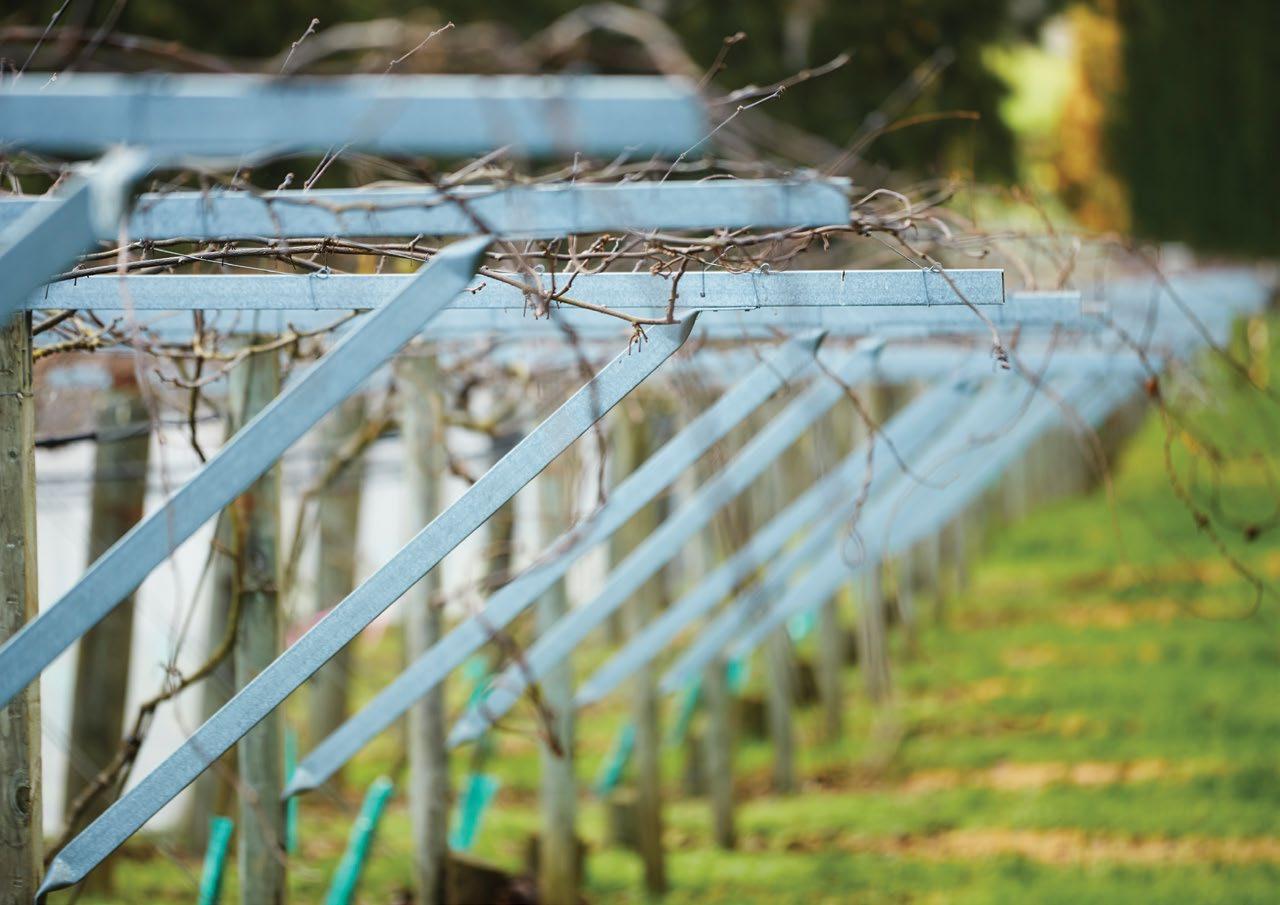






KIWIFRUIT STRUCTURE SOLUTIONS NZ made steel products | Proven reliability | Labour efficient | Built for growth Call Mike 07 282 1538 | agsteel.co.nz AG-BEAM AG-SUPPORT POST AG-Steel Product Range AG-TRIPOST AG-STRINGING POLE AG-BRACE

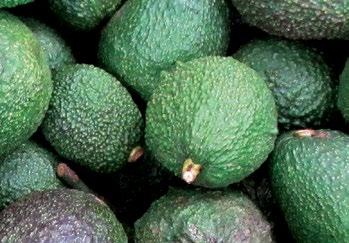

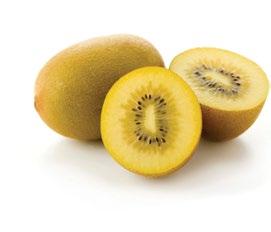
20 NZGAP marks 25 years of delivering trust
23 Consumer prices mask underlying economic and wellbeing concerns
24 Investment changing traditional ownership
27 Be clear about the problems that genetic engineering can solve
28 Trading with our Blue Pacific neighbours
34 Considering tamarillos on your orchard?
37 Season review: Mixed bag for cherries
40 Secondary markets and reducing food waste
44 Roading a challenge but still best option for freighting food
48 No growth without infrastructure
Technical
51 Growing knowledge in summerfruit understorey project
54 2024 Season in review
58 El Niño in a changing climate
Final pick
60 Avocados: hope for upcoming season
What’s New
A regular advertorial section of new products and services. This publication does not endorse the products or services featured here.
61 John Deere’s unprecedented commitment to HVC
On the Cover: At Southern Belle Orchard near Matamata with Jason Rama picking feijoas. See page 13. Photo by Trefor Ward
Up Front 2 President’s Word: Food security an issue for New Zealand – surely not! 5 The Chief Executive: Providing a reliable and resilient supply of fresh fruit and vegetables Your Levy at Work 6 HortNZ launches foundation health and safety training programme 8 Vote in the HortNZ Levy referendum 10 No retreat from elite soils on flood plains Your Industry 13 Feijoa picking regime key to quality 16 Golden year for gold kiwifruit in Tasman
Contents MAY 2024 28 40 16 60 The ORCHARDIST : MAY 2024 1
Food security an issue for New Zealand – surely not!
New Zealand exports over 80 percent of the food it produces, and our country can grow nearly anything with great soils, high sunshine levels, and a favourable temperate climate. Considering this then, why is Horticulture New Zealand raising the issue of food security for New Zealand?
Barry O’Neil : HortNZ president
Unfortunately because there are good reasons why we need to be concerned about Aotearoa New Zealand’s future food security.
While it’s a fact that over 80 percent of the food we produce is exported, this varies significantly depending on the type of food, and is definitely the case with dairy and meat and some fruit categories. However, over 80 percent of our fresh vegetable production is consumed within New Zealand.
Fresh fruit and vegetables are a really important part of our lives and positively impact our health.
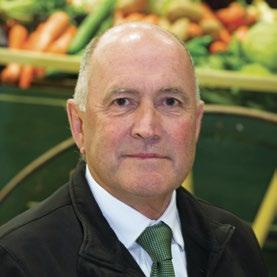
The New Zealand Ministry of Health and also the World Health Organization keep reminding us that one way to live healthier lives is to consume more fresh and nutritious fruit and vegetables. Likewise, 5+ A Day encourages all Kiwis to eat five or more servings of colourful, fresh vegetables and two servings of fruit every day for better health.
Scientists tell us that a diet rich in fresh vegetables and fruits can lower blood pressure, reduce the risk of heart disease and stroke, prevent some types of cancer, lower risks of eye and digestive problems, and have a positive effect upon blood sugar, which can also help keep appetite in check.
Although consuming all fruits and vegetables is beneficial health wise, when health studies have looked more closely into cardiovascular disease they found that green leafy vegetables such as lettuce, spinach, silverbeet, and mustard greens were most strongly associated with decreased risk of developing cardiovascular disease. Other vegetables such as broccoli, cauliflower, cabbage, brussels sprouts, bok choy and kale, along with citrus also made important contributions. We know how to grow vegetables, so if there is demand surely we don’t have a food security problem… unfortunately wrong!
It is believed this has been driven by the lack of affordability based on other family priorities, along with lack of education as to the value of eating a fresh healthy diet. There is also of course the issue of the time needed to cook rather than going for convenience with processed or fast food.
Unfortunately this has contributed to New Zealand having the third highest adult obesity rate of OECD (Organisation for Economic Co-operation & Development) member countries, with 30 percent of our adult population classified as obese, and even more unfortunately Māori are at 50 percent and Pasifika at 70 percent. The health impacts from this are huge, both for the individuals and for the ability of the New Zealand health system to provide care.
So how have we got it so wrong here, and what can be done to ensure plentiful supplies of affordable fresh fruit and vegetables for our population?
The real problem with vegetable production is while demand has (or should have!) increased as our population has increased, production hasn’t always followed. Overall, the number of vegetable growers has reduced significantly in the last ten or more years, primarily from family market garden businesses closing. A recent survey in Australia indicated 30 percent of vegetable growers are planning to exit the industry in the next 12 months if they can, due to lack of succession planning interest from their family, along with low profitability – and my feeling is New Zealand is not far behind this scenario.
As a country we have been reluctant to put policy settings in place to protect highly productive land as urban sprawl continues. And much of this land is land that has grown vegetables. It’s nothing new. Lower Hutt vegetable production had to relocate to Horowhenua after the then government bought up large areas of prime horticultural land in the Hutt Valley during the 1920s for housing, leading to growers moving to Ōtaki and Levin.
2 The ORCHARDIST : MAY 2024 PRESIDENT’S WORD
About 10% of Kiwi kids live in homes that are food insecure increases to 35% for Pasifika increases to 25% for Māori
Input costs have gone through the roof, with seed, fertiliser, diesel and labour being the main drivers, but prices for vegetables in general have not increased. There are always some unseasonal spikes, but in general vegetable prices have not kept pace with the costs of production; and with the use of distribution centres and the supermarket duopoly the grower often gets less than half of what the product is finally sold for, yet they take all the risks! And vegetable growing land is often very close to urban communities, which results in rates being high reflecting the value of the land for likely future industrial or urban development. Water is essential for vegetable production but has become increasingly difficult to access as demand outgrows supply, and as I wrote last month while we as a country have an international competitive advantage with fresh water, we have failed to fully utilise this wonderful asset. Vegetables are often grown using rotation, so moving crops to different locations within a catchment is normal, but the regional policy settings often don’t provide for this, nor for moving water allocation in the process. It’s bonkers that dairy farming is a permitted activity or has a viable consenting path in our key growing vegetable regions, but that vegetable growers can’t get the consents they need to operate!
Environmental restrictions related to sediment run-off, nitrogen application, along with social licence issues from noise, dust and spraying have all put increased pressures on the ability to grow vegetables, or to grow them where growers want to, and in a way that production is sufficient to provide a viable economic return. Vegetable production has a very small footprint of around 50,000 hectares, or 0.5 percent of all farmland, yet it is one of the most restricted agricultural activities.
HortNZ has been strongly advocating for policy settings to address these areas, to allow for all horticulture to grow and expand, including for vegetable growers to do what they do best, grow fresh healthy and nutritious vegetables. Sometimes we get criticised that with food security we are being too domestically focused with vegetables, and there is a perception that we are not putting equal efforts into supporting export industry issues, which is not correct. But also the reality is that the related risks and restrictions involved are impacting on all horticulture, whether that be the future growing of vegetables or fruit. We will continue to advocate strongly for logical and sensible solutions that are needed for future horticulture production. Our three priorities which I have covered over the last three months in this column, are climate mitigation and adaptation, water use and storage, and last but not least, food security. Our recent engagement with growers over our levy renewal has reinforced the importance of all three, as covered in our Growing Together 2035: Aotearoa Horticulture Action Plan
Kia kaha
Boost your orchard
Getting trees in the ground is no easy feat. That’s why we’re supporting local growers and New Zealand’s pipfruit expansion with market leading and consistently performing trees including high performing pollinators. Boost your orchard’s productivity with pollinators this winter.
LIMITED POLLINATORS
Granny Smith
Crabapple
The perfect pick for pollinators and hassle free growing.
AVAILABLE: sales@gnl.nz 021 827 831 Enquire today for XXX dispatch
Get in touch to order your trees today. sales@gnl.nz 021 827 831
Providing a reliable and resilient supply of fresh fruit and vegetables
With autumn well and truly with us, I’ve been reflecting on the outcomes of our meetings with growers over the past few months.
Nadine Tunley : HortNZ chief executive
I’m pleased the feedback from these meetings across the country has confirmed we are broadly on the right track.
Growers clearly have the same top priorities as Horticulture New Zealand – water, climate change and adaptation, and food security and supply.
Across the globe, the notion of food security has become increasingly important, and in New Zealand a key aspect of that is access to fresh fruit and vegetables. We also know that fresh fruit and vegetables are fundamental to human health and wellbeing.

The horticulture sector plays a vital role in New Zealand’s food security. Approximately 80,000 hectares of land is used for producing fruit and vegetables, providing over 40,000 jobs. Over 80 percent of fresh vegetables grown are for the domestic market, with many varieties of fruit also serving the New Zealand market.
For years, New Zealand has taken food security for granted. However, the Covid-19 pandemic and ongoing adverse weather events, such as Cyclone Gabrielle, have shown us that it is possible to suddenly have supermarket shelves empty of fresh produce.
Increasing growers’ ability to grow and expand by improving access to land and water will improve food security and help increase supply and therefore, the availability of fresh vegetables across New Zealand.
HortNZ is advocating for policy and regulatory settings that enable growers to provide a reliable and resilient supply of fresh fruit and vegetables and contribute positively to New Zealand’s food security.
That’s why we recently called on the government to ensure changes to the Resource Management Act (RMA) do not put vital domestic fruit and vegetable production at risk.
Acting Editor: John Gauldie
Email: editor@hortnz.co.nz
Advertising Manager: Jackie Enright
Ph: 04 494 9986
Mobile: 0274 489 913
Email: jackie.enright@hortnz.co.nz
Design:
Scenario.co.nz
Ph: 04 385 9766
Email: joy@scenario.co.nz
Subscriptions:
Email: info@hortnz.co.nz
This publication uses vegetable based inks and environmentally responsible paper produced from Forest Stewardship Council® (FSC®) certified, Mixed Source pulp from Responsible Sources.
Paper produced using Elemental Chlorine Free (ECF) and manufactured under the strict ISO14001 Environmental Management System.
The wrapper we use is 100% recyclable, it is LDPE 4 (Low Density Polyethylene) Soft Plastic and meets the required standards. For further information refer to: https://www.recycling.kiwi.nz/our-story
THE CHIEF EXECUTIVE
4 The ORCHARDIST : MAY 2024
We are seeking a range of amendments to proposed reforms, including recognition of the national importance of protecting highly productive land (HPL) for primary production and enabling the supply of fresh fruit and vegetables. We accept that people need houses to live in, but they also need to eat fresh fruit and vegetables. If the government makes building houses easier, then it also needs to make changes to the RMA to enable the supply of fresh fruit and vegetables.
If the amendments do not recognise the importance of domestic food supply, it will increase the risks to New Zealand’s food security and exacerbate the cost-ofliving crisis.
The New Zealand population grew by 138,000 last year, but council rules are currently preventing vegetable growers from growing more produce.
While housing has gobbled up highly productive land over the past ten years, the area for growing vegetables has not expanded at all. This is because the RMA is preventing vegetable growers from expanding in many regions.
2024 Horticulture New Zealand Director Elections
Calling for Nominations for two Directors

The Horticulture New Zealand constitution provides for a term of three years for elected directors.
The following Directors retire by rotation this year.
Bernadine Guilleux is retiring by rotation and is offering herself for re-election.
Brydon Nisbet is retiring by rotation and is offering himself for re-election.
There are two vacancies to fill.
New Zealand’s existing food production systems are coming under increased pressure:
It is vital for our country’s food security that fresh fruit and vegetables can be grown and supplied through a network of growing areas all around the country.
Providing for the supply of fresh fruit and vegetables will help growers produce more healthy food to feed New Zealanders at a reasonable cost, while incorporating best practices to boost our precious soils.
New Zealand’s existing food production systems are coming under increased pressure from population growth, climate change, and the need to improve environmental outcomes.
The importance of food security should be explicitly recognised to ensure that a reliable supply of fresh and healthy food for New Zealanders is achieved.
In accordance with Clause 12 (e) of the Horticulture New Zealand Constitution nominations are now being sought from individual grower members, affiliated Product Groups and affiliated Grower Associations.
Candidates must be nominated by at least two grower members or affiliated organisations.
The election is based on electing the best person for the job with no allocated seats for product, sector or regional representatives.
Candidate criteria
Nominated candidates must be:
• a person who is an active grower member of HortNZ; or
• a director, shareholder, partner or trustee of an active grower member who is appointed by that member as the principal representative of the entity in their dealings with HortNZ; or
• an employee of an active grower member who is appointed by that member as the principal representative of the entity in their dealings with HortNZ.
If more than two (2) candidates are nominated, an election will be held where individual grower members will vote for their preferred candidate. A profile for each candidate will be included with the voting papers distributed to growers.
The nomination form and position description is available on HortNZ’s website www.hortnz.co.nz or can be requested from the Board Secretary by emailing admin@hortnz.co.nz or by phone 0508 467 869.
Nominations close at 5.00pm on Friday 5 July 2024
.................... population growth .................... climate change .................... environmental outcomes The ORCHARDIST : MAY 2024 5 THE CHIEF EXECUTIVE
YOUR LEVY AT WORK
INDUSTRY WIDE ISSUES FOR INDUSTRY GOOD

HortNZ launches foundation health and safety training programme
Horticulture New Zealand in partnership with ACC (the Accident Compensation Corporation) is launching a major new initiative as part of its Grow Home Safe programme, with the aim of improving health and safety outcomes, particularly for seasonal workers.
The Foundation Passport – Horticulture course is an online training programme comprising five interactive training modules and includes hard-hitting personal accounts from workers who have suffered accidents.
Those completing it receive a digital site safety card to demonstrate they have undertaken basic health and safety training.
HortNZ Grow Home Safe project manager Matt Thorn said the project has involved input from 13 different grower groups and is based on a successful programme undertaken by the construction sector.
“We worked closely with every part of the industry from cherry orchards to kiwifruit growers and those producing vegetables – because we wanted to cover off all aspects.
“We looked at sectors such as the construction industry for guidance on how to roll out such a programme. The construction sector’s online programme enables someone joining a company from overseas to complete a course, and if they move to another company, they have something to show they have done that training.”
Grow Home Safe is run by HortNZ and is co-funded by ACC through a Workplace Injury Prevention Grant and
HortNZ grower levies. Its goal is to enhance safety and wellbeing in horticulture, built around four objectives: Understand, Intervene, Support and Lead.
Each objective addresses a specific problem to establish new approaches to reduce harm.
Over 40,000 people work in the sector each year, many of whom are seasonal workers.
“Through working with employers, we identified the need to provide these workers with some fundamental knowledge about what to expect,” says Matt.
“It’s also about empowering growers to engage their workers in gaining health and safety knowledge and awareness.
“Some of it is very basic. Many of these people have never done outdoor work. So it’s things like making them aware of the environment they are going into, and that they need to dress appropriately for the conditions –cover up, bring a hat, sunscreen and plenty of water and a packed lunch because they aren’t going to be able to nip to a shop for a snack.
“We’ve also explained Kiwi terminology because when you have come from overseas you might not understand things like ‘smoko room’. These are addressing real issues employers have told us they encounter.”
There is also a strong focus on addressing the key injury risks in the sector, including working at heights, and strains and sprains.
6 The ORCHARDIST : MAY 2024

“A lot of work in the industry is paid by the bin, so the faster you work the more money you make,” says Matt. “We have covered sensible lifting practices, managing fatigue and the importance of taking breaks, eating properly and taking a day off if you need to because you won’t be able to work if you get injured.
“We have also split the programme into different parts, indoor and outdoor, because the risks in the packhouse, like forklifts, are going to be different to those working outdoors.”
Matt says the online programme should take about four hours to complete, and participants will need to be focused throughout.
“It’s very interactive, you can’t just press a button, go away and come back later and you have passed. You have to move icons around and put them in the right boxes and it’s designed so you have to watch the videos.
“There are some very powerful interviews with people who have suffered accidents in the industry – for instance, one person who was up a Hydralada and made contact with overhead power lines and caught fire.”


To find out more about this new online training programme contact matt.thorn@hortnz.co.nz. There are a limited number of subsidised courses available. Growers are encouraged to get in touch.

1.95% interest | 30% deposit with 36 monthly payments. GST paid back in 3rd month. T&Cs apply. ORCHARD TRACTOR STOCKTAKE SALE P: Sales 022 573 8030 or 022 573 4910 E: sales@boptractors.co.nz | www.boptractors.co.nz LANDINI REX DT80GE $59,900 + GST The
online training
five interactive training modules The ORCHARDIST : MAY 2024 7 YOUR LEVY AT WORK
Foundation Passport – Horticulture course is an
programme comprising



Vote to grow together
No retreat from elite soils on flood plains
Highly productive land, New Zealand’s elite soil, is a precious asset for our fruit and vegetable production. It is no accident that this fertile land often sits on flood plains, because flooding or moving boundaries of water bodies allow nutrient-dense sediment to settle on the land.
Emily Levenson : HortNZ environmental policy advisor
With the knowledge that climate change will bring more severe rainfall and flooding events, policymakers have considered how New Zealand should adapt our planning processes. It makes sense that building new housing, schools or hospitals in the paths of future floods and slips is untenable, but the flood plains that are restricted for development should still be utilised for food production.
Despite the oft-cited statistic that New Zealand produces enough food to feed 40 million people, that number only applies if people are happy to subsist on milk powder. Our country’s fruit and vegetable supply is under pressure from restrictive planning rules, the high cost of inputs and labour, and market pressures. The more that climate change and geopolitical events put the squeeze on international supply chains, the more likely that imported food becomes unaffordable or unavailable and the more important it is that our geographically isolated country can grow our own food supply.

Regional councils should be directed to work with the rural community to coordinate and align private and public drainage systems to ensure that flood waters do not leave public networks just to subsume production land. Flood protection should cover areas where high capital safeguards are in place to protect investments like orcharding trees, which take several years to pay for themselves. Flood protection infrastructure should not be designed such that it worsens flooding on horticultural land, because that would exacerbate adverse impacts on domestic food supply.
We still need to maintain road connectivity when an area is determined too risky for housing but still suitable for food production. Roads are critical to ensure timely distribution of perishable produce from the source to consumers. This is especially important in times of natural disaster to ensure food security, so that growing areas are not cut off when we most need a consistent supply of food. Rural communities need multiple paths to evacuate in times of disaster in case one is cut off by a natural hazard like a slip.
Our country’s fruit and vegetable supply is under pressure from restrictive planning rules, the high cost of inputs and labour, and market pressures
Although horticulture should not retreat from highly productive land, we still need to protect our food resources from floods, to build resilience into our food system and ensure our population has access to affordable, healthy and culturally appropriate food. Drainage works, channel clearance and ongoing maintenance of flood protection infrastructure are needed in the rural environment to avoid or mitigate the effects of flooding and support rural production. The government needs to continuously strengthen grey infrastructure like stop banks and remove silt and shingle from flood channels to prevent dangerous debris flows.
There is a genuine risk to New Zealand’s food production and food security if horticultural businesses are accidentally caught in urban risk assessments and forced to retreat from highly productive land. Non-habitable horticultural structures and buildings that support horticulture but do not house people have a vastly different risk profile than residential areas. The policy framework for determining risk must accurately recognise the differences between urban and rural activities.
Read more on the Horticulture New Zealand website in our November 2023 submissions on the “Inquiry into climate adaptation and community-led retreat” and the “Proposed National Policy Statement for Natural Hazard Decision-making

”. Proposed National Policy Statement for Natural Hazard Decision-making 2023 CONSULTATIONDRAFT GOVERNMENTPOLICY SUBMISSION ON Inquiry into climate adaptation01 November 2023 To: Environment Committee Name of Submitter: Horticulture New Zealand Supportedby NZAsparagusCouncil, KiwifruitGrowers Inc.,TomatoesNZ,Potatoes ProcessVegetablesNZ, VegetablesNZInc Contact for Service: EmilyLevenson EnvironmentalPolicyAdvisor HorticultureNewZealand Box -232WELLINGTON 027 4423 Emily.levenson@hortnz.co 10 The ORCHARDIST : MAY 2024 YOUR LEVY AT WORK
WAIPĀOA RIVER
Tairāwhiti’s Waipāoa River created the Poverty Bay flats, an area that is both a flood plain and highly productive land (Land Use Classification (LUC) levels 1, 2 and 3). The land generates a large proportion of New Zealand’s vegetables, half its sweet corn and two-thirds of its citrus.

HORTICULTURE’S PRECIOUS FERTILE LAND
Agricultural land use comprises approximately a third of New Zealand’s total land area. However, horticulture crops grow on a tiny fraction – about 0.3 percent. Compared to other land uses, horticulture returns a much higher value per hectare, thanks in part to the fertile soils of highly productive land.
1, 2 & 3 Land
Gisborne Significant Flood Plains Gisborne Regional Boundry
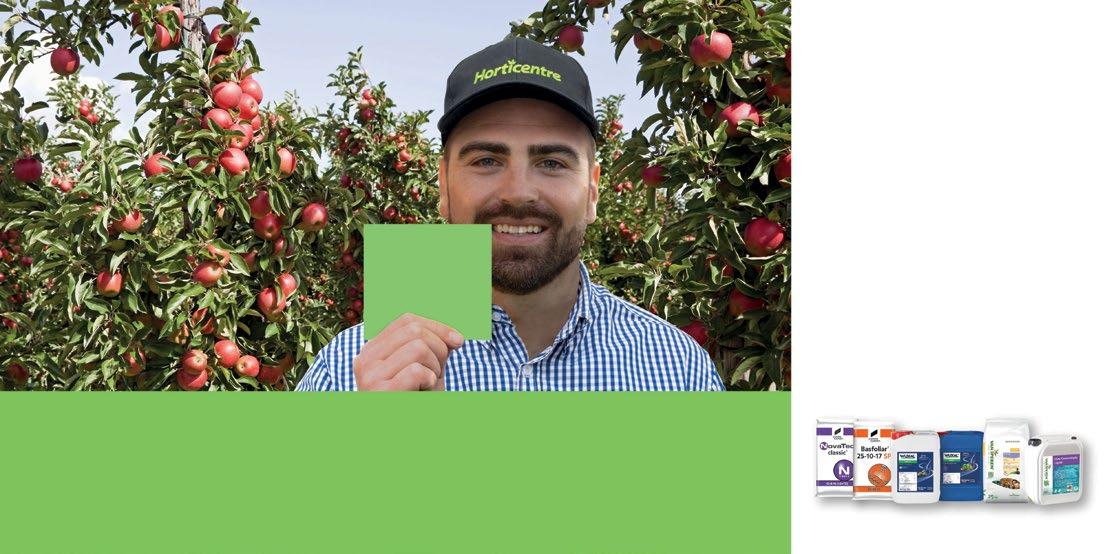


District Plan Flood Zones Additional Flood Zones sheep farming beef cattle dairy cattle vegetables vineyards fruit other livestock grain The ORCHARDIST : MAY 2024 11 YOUR LEVY AT WORK
LUC
YOUR INDUSTRY
ACROSS THE SECTOR — ACROSS THE COUNTRY
 Southern Belle picker Julieta Gonzalez
Southern Belle picker Julieta Gonzalez

Feijoa picking regime key to quality
Early on a misty Waikato morning at Southern Belle Orchard, situated ten minutes from Matamata, the pickers were out. Despite being wet from the dew, they seemed cheerful enough. Picking and sorting the fruit into two buckets, blue for touch-picked fruit directly from the tree and red for the dropped fruit off the ground.
Trefor Ward
The orchard was bought by Frans and Tineke de Jong nearly 20 years ago. More recently the day-to-day running of the orchard has been taken over by their son Talbert and his wife Emily, along with their growing family.
When asked how the season was going, Talbert says “we are having a way better year than last year in terms of production, so we have a lot more fruit. In the previous year, we lost about 80 percent of all our flowers when the frost hit the Waikato.” Unlike other crops that got hit and took a long time to recover, they lost flowers, and the trees weren’t affected. Temperatures got down to -6°C during flowering.
Although Southern Belle has a good amount of fruit coming off the trees, pricing has been pretty bad due to oversupply. Prices are still the same as they were 20 years ago.
Talbert says, “our emphasis on quality helps for sure. Touchpicking is really important to us, and really strict grading in the packhouse. Those who buy our feijoas know that we produce a high-quality product and want our produce.”
Most of Southern Belle’s feijoas go through MG Marketing in Auckland, Hamilton and Tauranga. They have some new plantings, have intensified one of their blocks, and have about 60 percent more trees in a hectare than they used to.
Growing 16 varieties of feijoas to get the spread over three months helps Southern Belle manage the picking and the picking staff. Kākāriki is their earliest fruiting variety, and Wiki™ Tu is one of the later varieties.
COVER STORY The ORCHARDIST : MAY 2024 13 YOUR INDUSTRY
Talbert de Jong with a feijoa variety called Kakapo which was planted in November 2023

RECIPE:
RONNIE’S
FEIJOA ICE BLOCKS
Blend together four feijoas, 100gm of crushed pineapples (tinned), the juice of one orange
Some varieties of feijoa produce less fruit than others. Pounamu underperformed, only producing two kilos per tree. Other similar-aged trees would produce more than 25 kilos. Talbert says he doesn’t know why, as the Pounamu variety does well for some other growers. With fruit trees, you have to wait a long time before you find out if something works for you. Whereas with their capsicums and chillies in the greenhouses, they quickly know if it doesn’t work and just put a new crop in the following year.
The property is five hectares, with three hectares in feijoas and 3,000 square metres of greenhouse growing the capsicums and chillies. These greenhouse crops are better for Southern Belle as they have a lot more control, while a frost can quickly wipe out the feijoas. The orchard has had feijoas on it for 40 years.
Growing 16 varieties of feijoas to get the spread over three months helps Southern Belle manage the picking and the picking staff
... and freeze in ice block moulds
Frans and Tineke are still involved in the orchard, though they have bought a campervan, so they try to get away. However, when it’s busy, it’s all hands on deck to get all the picking, packing and grading done. Emily is still handling a lot of the business side. She is in the packhouse when she’s not juggling the kids. Talbert is currently on daddy duties.
14 The ORCHARDIST : MAY 2024 YOUR INDUSTRY
Mark Barton and Julieta Gonzalez on the orchard, where touch picking is important for quality

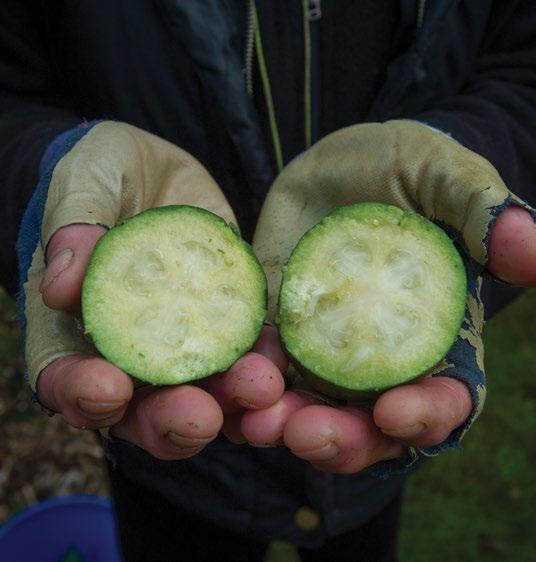
They have three boys, Ronald (5), Gordon (3) and Freddy (1), who all love feijoas. Especially when made into ice blocks, which Talbert says are “pretty yum” (see recipe opposite). Gordon says he wanted to go looking for feijoas during breakfast time and was disappointed he couldn’t go straight away at 7.00 am.
The feijoa industry is pretty tough right now. There are more and more plantings going in. Talbert thinks the big mistake many people make is not identifying their market, where the fruit will go, or working out the actual returns.
Most of the fruit at Southern Belle comes straight off the tree because they have an excellent picking regime.
ThermoMax
Touch-picking allows them to harvest a long-lasting, goodquality fruit. “We pick every second day, so even dropped fruit is of good quality and has a long shelf life, so we still grade it. A fairly large portion of the dropped fruit will go into a second grade or a juicing grade.” Talbert says there’s not much of a market for feijoa juice, so finding outlets for it is hard. They send very little fruit for processing or to the farmers’ markets, just a few grades.
To reduce their reliance upon the feijoa market, Southern Belle is considering culling older plantings and putting something else in. However, Talbert isn’t sure exactly what to replace them with yet.
• Provides internal warming more compact flowering
• For use on fruit tree crops
• The “spray on” that adds to all other methods
• Good results have been achieved when applied through irrigation lines







0800 735 859 www.bdmax.co.nz See the website for HortResearch report 10264 & 9 years of grower experience. Available from Farmlands & Horticentre. Excellent results to -2°C
Frost Protection
The ORCHARDIST : MAY 2024 15 YOUR INDUSTRY
A strong harvest this year combined with increased plantings in the industry is creating oversupply in the market

Golden year for gold kiwifruit in Tasman
It has been a golden run for gold kiwifruit in Tasman as all the stars aligned to produce “phenomenal” fruit this year.
The region may have been declared a drought and some apple varieties as well as green kiwifruit were smaller because of the dry, but for gold kiwifruit it was a “vintage” crop.
Mainland Kiwifruit Growers business and supply chain manager, Luke McKay, is the man who describes Tasman’s gold kiwifruit as phenomenal this year, and he expects the region to pack 3.7 million trays at 15,000 to 16,500 trays per hectare, which is slightly higher than last year’s gold crop of 3.6 million.
“The gold is great. The crop is actually very clean and we’ve got excellent dry
Anne Hardie
matter for eating experience. It’s as good as it gets for this district and for industry average.”
That is partly due to the long, dry summer and autumn that has caused bores to run dry in some areas and stressed plants but been ideal growing conditions for the gold kiwifruit.
Tasman was one of the driest regions in the country through summer and autumn – at least until the drought broke in mid-April. Though the region was declared a drought, it never quite tipped into a meteorological drought, despite a severe lack of rain.
According to the NIWA (National
Institute of Water & Atmospheric Research) New Zealand Drought Index (NZDI), that is due to other dryness indicators such as soil moisture and potential evapotranspiration.
However, Meteorologist Seth Carrier says the dry period began long before summer, with severe rainfall deficits dating back to last winter, adding up to eight or nine months of belowaverage rainfall. The cumulative effect of consecutive drier-than-normal seasons also played a role.
For growers, the severity of the drought depended on location.
FEATURE ARTICLE 16 The ORCHARDIST : MAY 2024 YOUR INDUSTRY
Lauren Henry from Wakefield on quality control of gold kiwifruit at Willisbrook Orchards

Around Motueka, Riwaka and over the hill in Golden Bay, there was ample water for irrigation. In early March, while most of the Waimea Plains’ orchards were on water restrictions, the recently completed Waimea Community Dam finally reached the stage where it could release water into the river and recharge the aquifers. Though apple growers in the Moutere had no such reprieve and many were using irrigation to look after the higher-paying varieties only due to water restrictions.
Luke says the lack of “a monthly douse of rain” took its toll on the green Hayward kiwifruit which in mid-April was resulting in smaller fruit, though he says it could still size up as harvest continues.
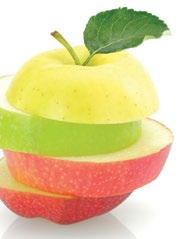
An estimated 1.2 million trays of green are expected to be harvested from the region this year at 7000 to 7500 trays per hectare, taking the total Tasman kiwifruit harvest including gold to an estimated 4.9 million trays. That’s just short of what is considered a full crop for the region of five million trays, but Luke says the value is still there with the gold quality.
Golden Bay Fruit chief executive and New Zealand Apples and Pears director, Evan Heywood, says one of the benefits of the drier season was an earlier start on the gold harvest for many growers, to capture Zespri’s incentive payments for early fruit.
“Nelson had a great start with the gold. We might not be the earliest in the
3.7 million trays
Expected 2024 harvest.
(compared to 3.6 million trays in 2023)
country, but we’ve had a pretty good result with early volumes, certainly way more than last year. Size is bigger than industry average, the crop volume is there and dry matter is better than last year. So, it’s a pretty good picture if you’re a gold kiwifruit grower. You would say it’s a good vintage if you were a grape grower.”
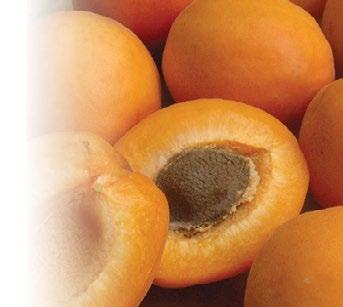

 A team plucks gold kiwifruit from the vines at Willisbrook Orchards
A team plucks gold kiwifruit from the vines at Willisbrook Orchards
Est 1956 L.E. Cooke Ltd L.E.
Growers of high quality fruit trees your fruit tree Try us first for requirements! Marty & Kelli Cooke 75 York Road, Longlands, Hastings, 4120 PH: 06 870 7043 EMAIL: lecooke@xtra.co.nz CELL: 0274 396 205 (Marty) NurserymanLtd •Pears •Plums •Apples •Apricots •Cherries •Peaches •Nectarines www.lecooke.co.nz Proudly serving the fruit industry for 68 years The ORCHARDIST : MAY 2024 17 YOUR INDUSTRY
Cooke Nurseryman


He attributes the gold quality with the resulting dry matter to not just the long, dry summer and autumn, but all the essential factors lining up from the time of pollination. Spring conditions were ideal for pollination; frosts were few and growers were able to get a good canopy up and growing in early spring.
“On top of that we’ve had a dry summer, so we’ve been able to check the vigour in the canopy. Everything has lined up for gold this year. Last year was a pretty tough season for a lot of growers because of dry matter, so this is significantly better.”
Added to quality, labour has been available in the region and the fruit has flowed out of the port easily. Luke says this year the port had two charter vessels in a row for the first time, and in early April the industry began loading container ships as well. He says it was fortunate the Australian port strikes were resolved before the crop was harvested or that would have affected empty vessels heading to New Zealand from its ports.
When it comes to the apple harvest, NZ Apples and Pears expects the Tasman region to produce similar export quantities of apples and pears as the 2023 season which was 105,185 export tonnes. That’s up on 2022 when it was 89,700 tonnes during Covid-19 challenges, and 2021 at 76,301 tonnes which was the year of the Boxing Day hailstorm as well as challenges during the pandemic.
The 2024 harvest is generally a “high-quality year for apples”
Evan says the 2024 harvest is generally a “high-quality year for apples”, with some varieties impacted by the drought more than others.
“We have most of those things the market wants around brix levels, pressures and colouration – we have a nice crop.”
Around Motueka and Riwaka, he says growers generally had an adequate supply of water as the aquifers fill from the Motueka River which has a large catchment. But he says rain always achieves a better response in trees than just “pouring water on a certain part of the ground” through irrigation.
That has led to Royal Gala in particular producing smaller apples. He says smaller Royal Gala in Hawke’s Bay this year, plus South Africa’s typically smaller apples means there will be larger volumes of smaller Royal Gala in the market this year, which will impact on price. Plus, smaller sizes do not attract higher prices anyway, he adds.
Envy™ is also smaller and varieties such as Braeburn and Pink Lady®, though he says the market does not want larger sizes of the latter two varieties anyway. The problem with Braeburn, Pink Lady and Jazz™ is the cost of production is higher than the returns growers are achieving, he says. Though growers are replacing those varieties in the orchards, he says there is still a reasonable amount in the ground.
Anna Otto is a horticulture cadet from Germany, now on quality control at Willisbrook Orchards
18 The ORCHARDIST : MAY 2024 YOUR INDUSTRY
Envy apples at the point of harvest on Willisbrook Orchards
Tasman region apple & pear exports (tonnes):
2021: 76,301
2022: 89,700
2023: 105,185
2024: expected to be around 2023 levels
On the Brightwater side of the Waimea Plains where Willisbrook Orchards grows 42ha of apples and 11ha of kiwifruit, the drought was a tale of two dams. On one side of the orchard, the Waimea Community Dam brought relief when it began releasing water and irrigation restrictions were lifted. The other side of the orchard lies in the Wai-iti zone and is reliant on the smaller Kainui Dam that releases water into the Wai-iti River.
Orchard manager, Rob Holtham, says wells in that zone ran dry in early March and two deeper bores ran dry in early April. The orchard has a sizeable Envy crop dependent on the Kainui Dam and he was thankful rain arrived not long after the bores ran dry because they were facing a zero take for irrigation water from mid-April.
Water is always crucial and he says the orchard has been working hard on all of its irrigation techniques and monitoring to be more efficient with the water that is available.
“We’ve made some changes over the last few years to a web-based irrigation system. It’s all online and we have weather stations and soil moisture probes in the orchard blocks and we’re managing it on a weekly basis. The level of reporting can show you what is working and what is not working – what is going on.”
Despite smaller fruit size, Rob says the quality of the apples is good this year.
“The apples are really good quality and good flavours to present to the market. That’s a real positive and we need to achieve that as growers.”
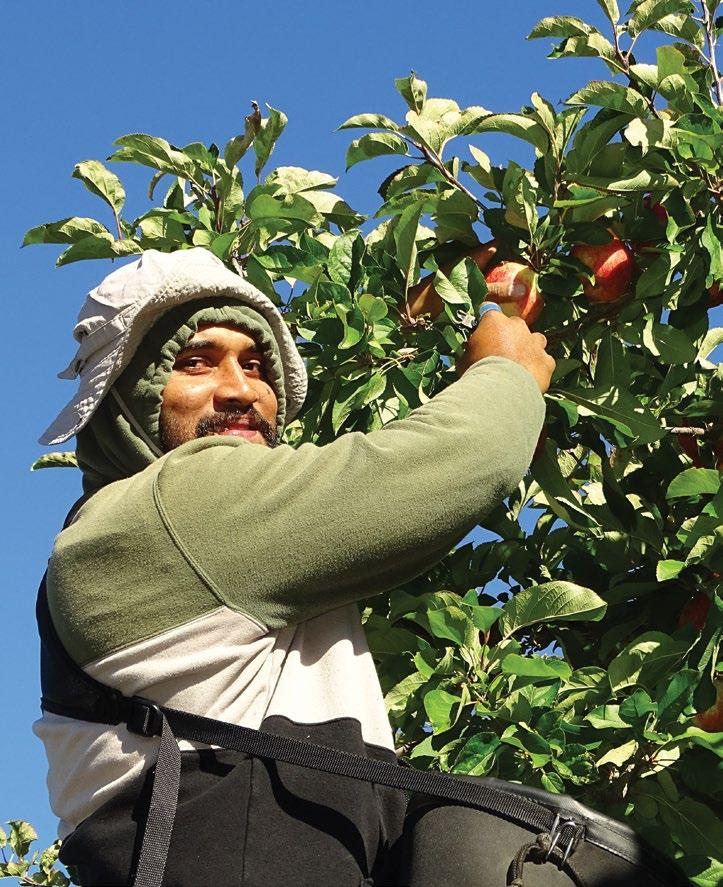


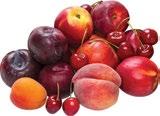
 Prune and heal with VistaSeal!
Available from Farmlands
Prune and heal with VistaSeal!
Available from Farmlands
The ORCHARDIST : MAY 2024 19 YOUR INDUSTRY
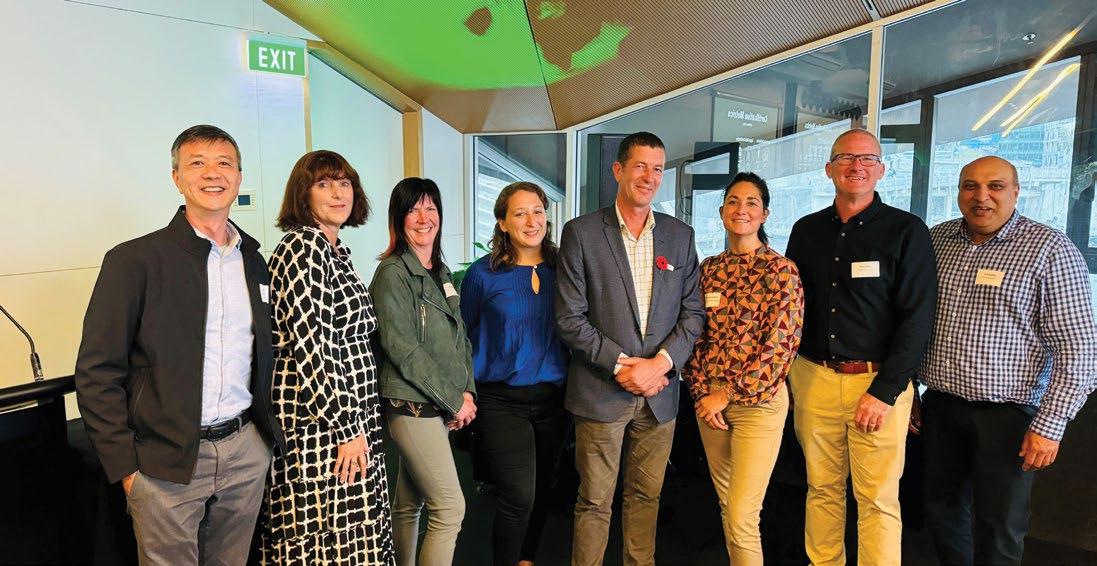
NZGAP marks 25 years of delivering trust
New Zealand Good Agricultural Practice (NZGAP) celebrates a major milestone this year after 25 years of providing assurance in the horticulture industry. Since the launch in 1999, NZGAP has been empowering growers to demonstrate the safe and sustainable production of fruit and vegetables, thus meeting the expectations of millions of consumers in New Zealand and around the world.
NZGAP general manager Damien Farrelly says that “consumers are increasingly concerned about the origin, safety and sustainability of their food. For 25 years now, NZGAP certified operators have been able to demonstrate their commitment and ability to meet these expectations.
“It is fundamentally about protecting growers’ social licence to operate. NZGAP enables that both at an individual and sector level via the robust and trusted assurance system which has continually evolved over the years to ensure it remains trusted and valued.
DELIVERING TRUST FOR 25 YEARS 20 The ORCHARDIST : MAY 2024 YOUR INDUSTRY
The NZGAP committee with Mike Butterick (Wairarapa MP) from left to right: Allen Lim, Kate Trufitt, Linda Flegg, Solenne De Durand, Mike Butterick, Bernadine Guilleux, Adam Jory, Kirit Makan
A cocktail style event was held recently in Wellington to mark the 25-year celebration. In attendance were Mike Butterick (Wairarapa MP), founders, growers, retailers, wholesalers, auditors, regulators, product groups, district associations, Horticulture New Zealand plus current and former NZGAP committee members and managers.
During the evening event, Bernadine Guilleux (chair of the NZGAP committee), who was MC for the evening, recognised Russell Jordan and Ron Gall, the driving forces behind the development of NZGAP and founding members who supported the programme from the beginning.
It is fundamentally about protecting growers’ social licence to operate
“When researching the early years of NZGAP, you can’t go far without seeing the name of Russell Jordan. He himself will say there were numerous others that helped and I’m sure he was right, however he was the driving force.
“The journey of NZGAP has been marked by significant milestones, each one a testament to the dedication and collaborative nature of our industry. It could be said one of the first achievements of NZGAP was gaining agreement from both the Vegetable and Fruitgrowers’ Federations of the time to support just one Quality Assurance Programme. This set the foundation for things to come.
Mike Butterick stated, “Our industry is a collective of great farmers and growers, with quality products to share to the world. We need easy, effective verification systems to make sure global consumers know just how good we are at our job!
“NZGAP puts significant effort into simplifying how growers are able to meet both market and regulatory requirements. Part of our role as government is to solve problems not create them!
“Minimising complexity makes sense to me, and I look forward to seeing more simplification and further red tape reduction. This government has already made changes that support New Zealand food producers and I look forward to seeing even more over the months ahead.”
In relation to NZGAP’s recognition under the Food Act, Vincent Arbuckle, Deputy Director General for New Zealand food safety at the Ministry for Primary Industries stated “This initiative reduces costs and streamlines administrative processes for these businesses. It’s a win-win situation”.
“From a food safety point of view, the advent of NZGAP is significant because it takes a risk-based approach to food safety, requiring the identification and control of food safety hazards. This meant NZGAP registered growers were well positioned when the horticulture sector was included under the food safety regime for the first time with the introduction of the Food Act 2014”, Vincent says.
Glen Bewley, merchandise manager at Woolworths New Zealand, a sponsor for the event, is a strong advocate for NZGAP and recognises its importance to meet consumer expectations. “We all know that NZGAP significantly contributes to the food safety of the New Zealand horticulture industry. Our work alongside NZGAP helps us to be confident that we can source fruit and veg from businesses that pay and treat their staff fairly – and of course are of safe and good quality standards.
Damien Farrelly, NZGAP general manager, spoke about the value of NZGAP to the horticulture industry, and encouraged “even more collaboration and engagement in this space to help set NZGAP and our growers up for success”.
Minimising complexity makes sense to me, and I look forward to seeing more simplification and further red tape reduction
“Minister Todd McClay and Minister Andrew Hoggard have recently said that officials are looking at ways to integrate existing industry assurance programmes into the Freshwater Farm Plan System. This is great news for horticulture. We want to see recognition of programmes like the NZGAP Environment Management System, which is trusted, robust and meets the desired policy outcomes.
PLATINUM SPONSOR GOLD SPONSORS
The ORCHARDIST : MAY 2024 21 YOUR INDUSTRY

“New Zealand’s growers are committed to adopting safe and sustainable practices and the industry is committed to supporting them. NZGAP empowers growers to demonstrate that they are meeting consumer and community expectations, and I would like to recognise everyone who has supported NZGAP with its commitment to simplifying compliance and building trust in horticulture over the last 25 years.”
The journey of NZGAP has been marked by significant milestones, each one a testament to the dedication and collaborative nature of our industry
Current NZGAP committee, past chairs, NZGAP managers and founders of the programme met for a workshop prior to the evening event to consider what the future looks like for NZGAP and how the programme is best positioned moving forward. Matthew Dolan, former NZGAP business manager who attended the workshop, said: “Starting NZGAP showed a lot of foresight. Growers realised if they didn’t take the lead on food safety, retailers and regulators would happily do it for them. I encourage NZGAP to retain its grower focus and to stay a step ahead of requirements as they change, otherwise the risk is having to deal with unworkable rules and escalating compliance costs”.
It is clear NZGAP is valued, and support for the programme is as strong as it was 25 years ago. It is also clear that amidst changing regulatory and market landscapes there is a need for NZGAP to continue to evolve and support growers to meet these requirements in the simplest way possible.
Past and current NZGAP managers (left to right): Peter Ensor, Matthew Dolan, Damien Farrelly
DELIVERING TRUST FOR
22 The ORCHARDIST : MAY 2024 YOUR INDUSTRY
25 YEARS
Consumer prices mask underlying economic and wellbeing concerns
The Orchardist staff
Plentiful harvests after generally fine weather so far in 2024 have provided a strong supply of healthy fresh fruit and vegetables. However, sluggish domestic and export demand for many crops has put further downward pressure on prices.
In mid-April Statistics NZ reported a 13.3 percent drop in fruit and vegetable prices in the 12 months to March 2024.
“The annual decrease in fruit and vegetable prices was the largest recorded since the series began in 1999,” Stats NZ consumer prices manager James Mitchell said.
While good news for many New Zealanders doing it tough, growers continue to face higher input costs such as labour, fuel and interest. The recent price volatility is putting a further crunch on already stretched grower finances.
With inflation still running high, the falling prices for fruit and vegetables are unlikely to be reflected in other consumer costs such as grocery items and home ownership. Vegetables NZ chair John Murphy says that up until recently, economists have been saying that vegetables are expensive.
“What was missing in their commentary was that compared to some of the other items that shoppers buy, fresh inseason vegetables are still good value, particularly from a health and wellbeing point of view.”
Only one in every four Kiwis currently eats the recommended five or more servings of vegetables each day. Studies have shown that higher prices lead to reduced consumption of vegetables.
Research carried out by NielsenIQ for 5+ A Day last December showed half of all Kiwi consumers (50 percent) spend between $11 and $30 on fresh fruit and vegetables each week.
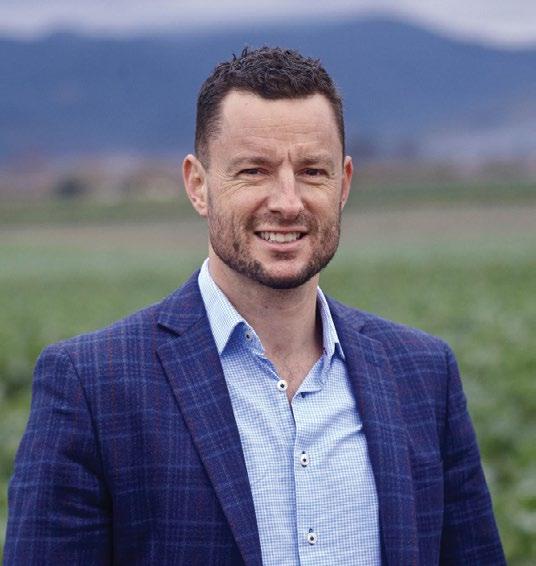
“That’s an indication of how low vegetable consumption is in New Zealand, which has a negative impact on wellbeing and adds millions of dollars to the cost of our health system,” says John.
The 2020 study by Dr Cristina Cleghorn at the University of Otago calculated that if New Zealanders eat 69 grams less vegetables per day, the country could see a sharp 58,300 reduction in health adjusted life years and $490 million costs added to the health system by 2042.
While good news for many New Zealanders doing it tough, growers continue to face higher input costs
“This situation is why we’ve launched the Add One More Vegetable campaign, to encourage people to take simple steps to boost their in-season vegetable consumption and improve their health.”
Without viable pricing, more growers may be forced out of business which will further affect domestic production, which is already too low to meet New Zealanders’ dietary recommendations, particularly for legumes and dark-green leafy vegetables, according to a 2021 study, Feeding the New Zealand Family of Five Million, 5+ a Day of Vegetables? by Fiona Curran-Cournane and Elaine Rush.
John Murphy, Vegetables NZ
The ORCHARDIST : MAY 2024 23 YOUR INDUSTRY
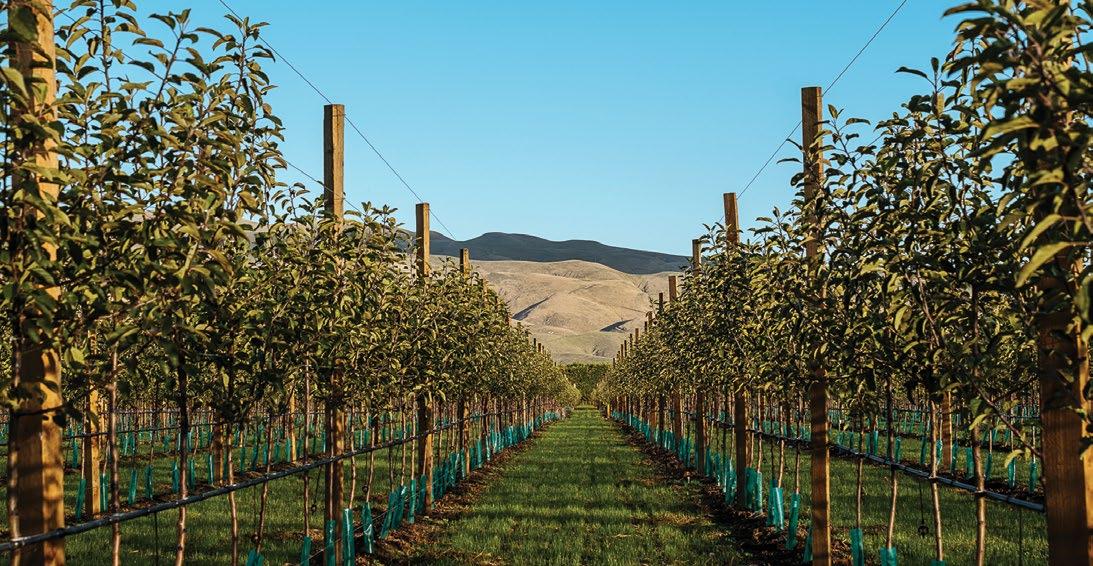
Investment changing traditional ownership
‘Off-orchard’ capital is increasingly making its way into horticulture, helping the sector to recover from climate onslaughts and prepare for the future.
Yet, as ELAINE FISHER discovers, some are calling for much more onshore and overseas investment. What will it mean for ‘mom and pop’ growers?
If the aims of the Aotearoa Horticulture Action Plan to double farmgate revenue by 2035 are to be realised, the industry will need more investment.
It is not just the horticultural industry which has aspirations for its growth. In December last year, the new Minister of Agriculture Todd McClay said: “To grow New Zealand’s prosperity and success on the world stage, the government has set an ambitious trade target of doubling the value of our exports within ten years, including from agriculture and forestry.”
However, investment is currently lagging behind the industry’s need for growth, says Andrew Watters, chief executive officer of MyFarm Investments.
MyFarm has prepared a draft report with the working title Deregulation needed to support primary sector growth to present to the Minister of Agriculture and
officials and major agri-businesses in New Zealand.
“It outlines our views. I’m not saying we are one hundred percent right, but this is a subject which needs wide discussion.”
To realise the ambitions of the sector, Andrew says barriers to accessing capital for businesses to scale up, or to access productivity enhancing technology must be minimised. His report says: “There may be a greater role for both foreign and domestic capital investment, which would help to expand production, drive innovation and productivity growth.
“Funding sources provided by government (such as Sustainable Food and Fibre Futures) and efforts to accelerate the ability for the sector to attract capital (Investment Accelerator programme) are examples of successful co-investment mechanisms.
FEATURE ARTICLE 24 The ORCHARDIST : MAY 2024 YOUR INDUSTRY
A new orchard developed by MyFarm Investments
“These need to be bolstered by KiwiSaver reform and reform of the Overseas Investment Act.”
MyFarm’s model for future growth includes a move to more corporate ownership at the cost of family ‘mom and pop’ owners. “Some good strong family businesses will still thrive but are likely to become the less dominant business model.”
Investment is currently lagging behind the industry’s need for growth
“No solution to industry growth is a perfect solution. It’s always complex. Solve one problem and you create another.”
Since 1990 MyFarm has offered investments in productive land-based assets. Today its syndicate properties are located throughout New Zealand’s top primary sector growing regions with land-based assets and infrastructure including vineyards, apples, avocados, kiwifruit, hops,
Some good strong family businesses will still thrive but are likely to become the less dominant business model
Andrew Watters, chief executive officer of MyFarm Investments

For families to stay on the land and for wider industry growth, there needs to be improved access to capital.
“We understand the squeeze on some families, including because of the age of owners, but change is part of the


The ORCHARDIST : MAY 2024 25 YOUR INDUSTRY
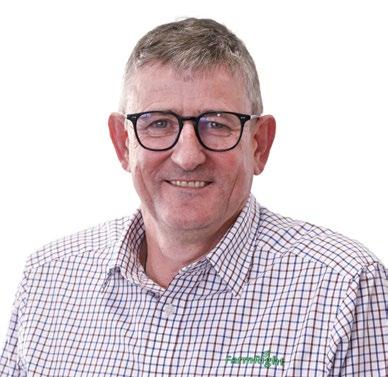
You can’t fight change, but you can take the opportunities it brings
Jim Lee, chief executive, FarmRight
However, FarmRight has had a successful partnership with the NZ Super Fund since 2010. It began with an initial dairy investment and is now a diverse portfolio encompassing horticulture, viticulture and hops with a value exceeding $1 billion.
Family-owned orchards were
the backbone of the industry and will still
have their place
Opportunity and capital go together, and Jim says there are plenty of opportunities for horticulture in New Zealand.
“We are seeing some productive land go to non-productive use such as housing, which is not preferable, but we need progress and people need somewhere to live.
“There is still a lot of land in New Zealand with the potential to grow horticultural crops. If the focus is on resources such as soil, temperature and water availability via irrigation or rain, there are areas outside traditional growing regions with land which could grow high-value horticultural crops. Land is not a major problem – but capital is needed to develop it.”
So what options are left for ‘mom and pop’ owners of horticultural land who don’t wish to sell up and stop growing crops?
Acquiring or leasing more land to grow is increasingly expensive. The report Business Succession in the New Zealand Horticulture Industry, by Iona McCarthy MBS, FPINZ Senior Lecturer School of Economics and Finance Massey University and Liz Dooley PhD, MNZIPIM Senior Consultant (Research) Perrin Ag Consultants Ltd, noted the challenge of “land values well in excess of productive capacity, which increase at a rate exceeding earnings potential.”
Releasing some of the horticulture sector’s ‘land bank’ equity is one way to generate capital for expansion, intensification and new technology, the report explains. It can also help diversify and manage risk.
There are many proven succession models to release equity and offer the next generation access to capital and career pathways within a family business. However, such a step is not without its complexities, including alignment between all investors and decision-making.
Horticultural succession information and examples of horticultural succession are limited, but the report says the agriculture sector had already identified succession as an issue and developed resources and workshops for their members e.g. DairyNZ, Beef + Lamb NZ and the Meat Industry Association. Many of those resources are generic enough to be useful to those in horticulture.

Business Succession in the New Zealand Horticulture Industry
Prepared for Ministry for Primary Industries



New Zealand Horticulture Industry, use the QR code or visit: www.mpi.govt.nz/ dmsdocument/44617-Business-Successionin-the-New-Zealand-Horticulture-Industry
2020 Prepared by Perrin Ag Consultants Ltd and Massey University Perrin Ag Consultants Ltd Registered Farm Management Consultants 1330 Eruera Street, PO Box 596 Rotorua 3010 New Zealand 26 The ORCHARDIST : MAY 2024 YOUR INDUSTRY
Report
prepared by
Perrin
Ag Consultants and Massey University
Be clear about the problems that genetic engineering can solve
Professor Richard Newcomb : Plant & Food Research chief scientist
The Minister of Science, Innovation and Technology Judith Collins recently confirmed that work is well underway to see through the government’s goal in the coalition agreement of introducing new legislation to liberalise genetic engineering. An extensive public consultation period could begin as early as the end of 2024. The legislation will attract views from across the primary sector, as well as medical and other biotechnology sectors. The horticulture industry needs to be clear what the issues are. Then you can match up the problem statement with the technology. That’s starting to happen. When we talk with levy organisations and company boards, they want to know what new genetic technologies can do – can we deploy these technologies in our crop and solve an industry problem?
The industry also wants to understand how consumers feel about gene editing
We’ll have to be careful about it. It’s not going to happen tomorrow. But overseas there are a lot of new products coming down the pipeline. In the United States, it’s a long, long list. There are companies pushing really hard to develop gene edited products. For some crops like berries, I think we’ll start seeing a number of these products emerge in the next few years.
One of the problems with the first-generation products [technology from the 1970s] is that they focussed too much on grower traits like herbicide resistance and not
 Professor Richard Newcomb
Professor Richard Newcomb
enough on consumer traits. So when you ask consumers what they think, they say what’s in it for me, just risk. So I think we’ll see more balance coming with consumer traits like non-browning apples in the United States and tomatoes high in gamma-aminobutyric acid (GABA) that lower blood pressure in Japan.
The industry also wants to understand how consumers feel about gene editing – across the many countries we export to. There’s not much point developing gene edited crops if nobody’s going to purchase them.
We probably need to talk more about the technology itself and what it can do. There are certainly still work-ons. You target a specific place in the genome and sometimes you get changes in other places that are not intended. But the technology is constantly improving. It’s probably at the point where most of the risks can be mitigated.
The potential impacts of the technology on soil are a knowledge gap. Everyone around the world is learning about the relationship between the plant and the microbiome. This research is really only in its infancy. But that’s just part of the risk/benefit landscape that we’re going to have to take into account when we make these judgements.
Certainly though, the issues this technology can address are wide. From environmental issues and climate resilience though to maintaining quality and enhanced health characteristics, this technology provides a much more rapid and precise pathway for developing the next generation of food products.
The ORCHARDIST : MAY 2024 27 YOUR INDUSTRY
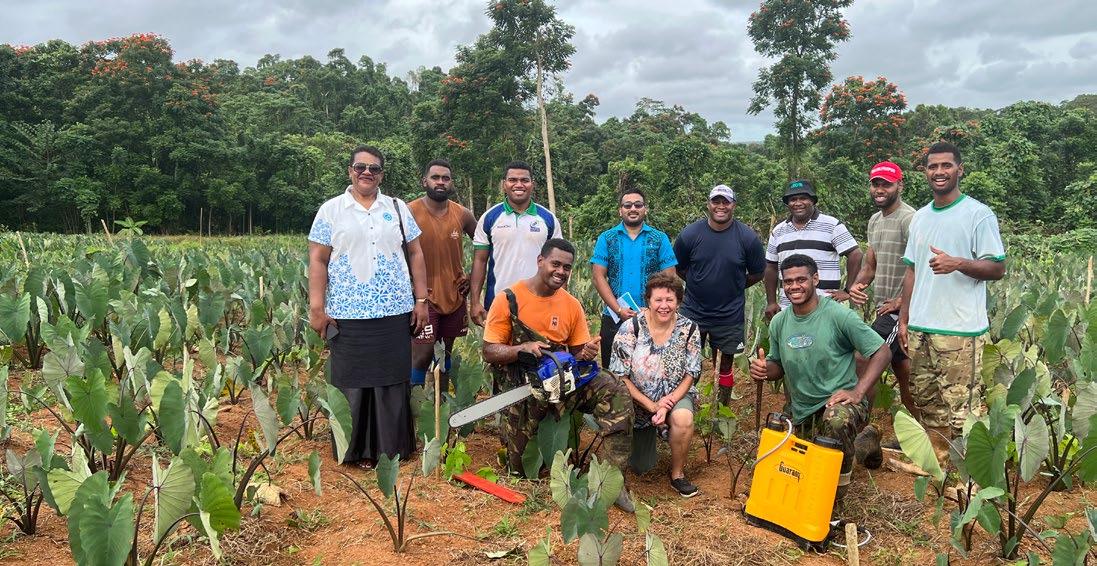
Trading with our Blue Pacific neighbours
Horticulture is extremely challenging for growers in the Pacific Islands.
New Zealand is a key exporter of fresh fruit and vegetables to ensure food is available, but we also have a role in supporting resilient local growers.
The Orchardist staff
Trading with the Pacific Islands is not easy, says Nicole Metzger, managing director at South Seas Exports, a company with 20 years of experience in the region. The market comprises more than a dozen nations spread over a vast ocean – each with their own market access issues, challenging logistics, and a huge range of products.
“We are shipping 300 different produce lines, it’s a real shopping basket. We load our own containers, mostly 20ft reefers and send regular airfreights.”
Potatoes are a well-known export commodity, but there is also a market for fresh fruit.
“Zespri is a big line going into the French Territories. Kiwifruit for them are like bananas in New Zealand, they’ll be eating one a day.”
Some of those countries are quite protectionist, but understandably so, says Nicole. Pacific growers face exceptionally challenging growing conditions, so putting local produce first is important for food security.
“As well as the import quota system in New Caledonia and French Polynesia, most Pacific Islands have some tariffs and specific phytosanitary requirements, but those generally apply equally to other nations like Australia so we are not more disadvantaged than our competitors.”
Supporting local produce is also important for resorts as eating authentic island fruits and vegetables contributes to the tourism experience, but New Zealand has a role to help ensure the continuity, she says. As a Pacific nation ourselves, New Zealand has strong cultural, social and economic ties that make us a natural partner.
FEATURE ARTICLE 28 The ORCHARDIST : MAY 2024 YOUR INDUSTRY
Pacific Trade Invest New Zealand (PTI NZ) Trade Commissioner Glynis Miller (centre) visiting a taro crop with a group of Fijian growers who are part of the AgriRugby academy – being coached rugby half-time, and concurrently learning agriculture and financial literacy – an initiative set up by Fijian rugby great Seremaia Bai. Photo courtesy PTI NZ
“I certainly notice that our clients prefer to deal with New Zealand. There is a connection there and we definitely value those strong relationships. We now have second-generation customers. Compared to some nations, New Zealand is focused on the Pacific, it’s not an afterthought.”
While the Horticulture Export Authority (HEA) system provides for a special lower cost Pacific export licence for some lines, only summerfruit and persimmons have taken this up. Quantitative exemptions exist for remaining HEA products like avocados, however there are no restrictions on non-HEA products (e.g. apples, onions).
Overall Nicole believes more could be done to streamline supply given the diverse and challenging nature of the market.
I certainly notice that our clients prefer to deal with New Zealand. There is a connection there and we definitely value those strong relationships
“When Australia has a good growing season, it’s hard for us to beat. Particularly for the Melanesian markets, Papua New Guinea and those places with geographic proximity. Fiji is a bit of a battleground and we’re strong further east in Polynesia. We’re fruit fly free which is a big advantage. Even if there are fruit fly present in the Pacific, they certainly don’t want to import more.”
New Zealand used to have better shipping services to the Pacific than Australia, but since Covid-19 the advantage has swung to Australia.
“Moving containers around in New Zealand has just become so expensive. It doesn’t help. The logistics are already really challenging in the Pacific.

The Pacific is sometimes overlooked but I think it’s a great export opportunity for growers
Nicole Metzger, managing director at South Seas Exports

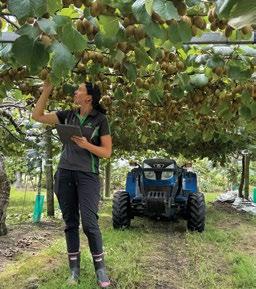
Recognised Seasonal Employers and Horticulture Conferences 2024 28-30 August, Mercury Baypark, Mount Maunganui
Early bird pricing available for a limited time Register at: www.hortnzevents.co.nz

 Kiwifruit are a consumer favourite in the French Territories –on display here in a New Caledonia supermarket
Kiwifruit are a consumer favourite in the French Territories –on display here in a New Caledonia supermarket
Registrations now open
The ORCHARDIST : MAY 2024 29 YOUR INDUSTRY
“We’re lucky that Tahiti is on the Maersk route. For the rest, there are shipping companies supplying most islands but the frequency is low. Offshore freight costs are high. There’s not a lot of competition for many of these ports. Plus we face delays caused by boats bunching up, storms and you have instances like when a cruise ship arrives, other ships have to leave the port.
“Samoa, Cook Islands and Tonga all have very good air connections. For some countries like Niue, air freight is the most reliable option.”
Despite the challenges, New Zealand horticulture should continue valuing trade with our Pacific neighbours, foster close ties and support the islands to develop resilient local growers.
New
Zealand exported $122m worth of vegetables, fruit and preparations in 2023 to the Pacific
“The Pacific is sometimes overlooked but I think it’s a great export opportunity for growers, for a lot of crops, it’s not just potatoes and onions. It’s cabbages, leeks and witloof… Small lines but it adds up. It’s a nice little additional outlet for those growers who aren’t supplying the supermarkets.”
Overall New Zealand exported $122 million worth of vegetables, fruit and preparations in 2023 (FOB value) to the Pacific, while imports from the region totalled $33 million.
Pacific Trade Invest New Zealand (PTI NZ) Trade Commissioner Glynis Miller says interventions by PTI NZ, PHAMA Plus (Pacific Horticultural and Agricultural Market Access Plus) and PACER Plus (Pacific Agreement on Closer Economic Relations Plus) unlock some of the technical barriers experienced by Pacific Island growers, and go some way to address the trade balance between New Zealand and the Pacific Island countries.
“New Zealand’s horticulture industry can do a lot for the Pacific, beginning with being active investors,” says Glynis. “New Zealand’s innovation in horticulture is outstanding. Concerted efforts should be made to share best practices with the Pacific region. Transferring one percent of New Zealand’s technical expertise in agri farming can be a game changer.”
New Zealand expertise from the private sector is already an element in some horticultural developments – such as help in extending island-based co-operatives in vanilla, honey and cacao production.
Plant & Food Research is active in the Pacific, including a five-year project funded by New Zealand Aid Programme to increase the resilience of the Tongan vanilla industry, with a target to increase production and improve quality.
The Tauranga-based company Heilala Vanilla is one of the two biggest Tongan vanilla exporters and a key collaborator in this project.
And Glynis notes that the success story of Niue honey –voted the best in the world at an international honey expo in London, “is in some way attributable to expat New Zealand staff at the operation.”
New Zealand also supports Pacific growers by reducing trade barriers. There are practically no tariffs on Pacific Island horticulture imports into New Zealand, however New Zealand maintains non-tariff measures, including those to manage biosecurity risks such as fruit fly.
Traditional Pacific crops have a rapidly developing export market, such as gluten free flours from breadfruit, banana, manioc and cassava, and frozen and dried taro. Other investments in export crops are targeting global specialty markets where Pacific conditions may provide a unique benefit, such as vanilla, cocoa and coffee.
Other tropical crops such as pineapples, mangoes and cut flowers face competition from New Zealand’s usual suppliers such as from Queensland.
“There are 152 existing pathways for fresh fruit, root crops, vegetables, cut flowers, foliage, etc.,” Glynis continues, “yet less than 50 percent of these are utilised. PTI NZ and its partners are currently working on a project to look at opportunities for Pacific growers in the New Zealand market.”
Ritesh Gosai, business development support at PTI NZ, says increasing domestic food supply and reducing reliance on imports can go hand in hand with developing export markets like New Zealand.
“Developing a robust domestic food supply often involves improving farming practices, infrastructure, and adherence to quality standards. These improvements can enhance the competitiveness of island nations’ agricultural products in international markets. By demonstrating the ability to produce high-quality agricultural products, island nations can attract interest from importing countries like New Zealand, leading to mutually beneficial trade relationships such as trade pathways.”
Freight costs are one of the top three barriers to export faced by Pacific businesses, and this situation was exacerbated by the disruptions to shipping created by Covid-19. PTI developed a freight assistance package to support Pacific exporters by reducing the cost of accessing international markets in a post Covid-19 recovery phase.
Ritesh says New Zealand and Pacific Island nations can explore collaborative initiatives to optimise shipping and air freight services, such as joint ventures, public-private partnerships, or regional agreements aimed at improving connectivity and reducing costs.
30 The ORCHARDIST : MAY 2024 YOUR INDUSTRY
FIJI –
NEW ZEALAND’S LARGEST PACIFIC TRADING PARTNER
$60 million exports
New Zealand’s fruit and vegetables FOB export revenue (NZD) to Fiji in 2023.
85% vegetables
Almost half of our exports to Fiji is potatoes, followed byonions and carrots.
$27 million imports
New Zealand is Fiji’s second largest crop and livestock market after the USA.
Source: Fiji 2022 Agriculture Annual Trade Report, Crop & Livestock Commodities/Products (Fresh/Chilled and Value Added)












































exports to Australia exports to New Zealand imports from Australia imports from New Zealand 23% exports to USA 16% 15% 9% 7% Fiji
The ORCHARDIST : MAY 2024 31 YOUR INDUSTRY


Health advocates keep fruit & vegetables in the spotlight
Despite living in a horticultural paradise, many Kiwis still struggle to eat enough fruit and vegetables to achieve a healthy, balanced diet.
The Ministry of Health recommends people eat five or more servings of vegetables and two servings of fruit daily. But recent research conducted by 5+ A Day Charitable Trust shows only 23% of New Zealanders eat the recommended daily intake of vegetables with 71% of us eating enough fruit.
Those findings led 5+ A Day to partner with Vegetables New Zealand to launch a new campaign to encourage people to Add One More Vegetable to their daily routine.
“Adding
one more serving per day benefits overall health outcomes. Studies show consistent decreases in disease risk are observed when people increase the diversity of the vegetables they eat.”
Dr Carolyn Lister, 5+ A Day Trustee and Principal Scientist and Team Leader at Plant and Food Research.
For more information about 5+ A Day visit the consumer website: www.5aday.co.nz and the education website: www.5adayeducation.org.nz
Follow @5adaynz on socials
The charity’s efforts to raise consumption and improve public health outcomes often involves supporting our littlest tamariki to embrace fruit and vegetables.
Fruit and Vegetables in Schools (FIS) is now supplying approximately 25% of primary schools/ kura in Aotearoa, ensuring children from schools high on the Equity Index (most deprived) don’t miss out on eating fresh produce. Around 27 million servings of fresh fruit and vegetables are now eaten every year by over 125,000 students and staff from 566 schools.



5+ A Day supports FIS by providing curriculumlinked resources that support learning on topics such as germination, composting and eating seasonally.
“Our free resources cover early childhood education right through to secondary school level. FIS supports food security for those who might otherwise go without. We’re making sure a whole generation of kids receive consistent, accurate health messaging.”
Carmel Ireland, Project Manager, The 5+ A Day Charitable Trust.





































Further 5+ A Day resources are also available for parents and whānau, health professionals and even workplaces who are keen to promote wellbeing. “The key is making fruit and vegetables an attractive, easy option and we’re constantly focussed on helping people incorporate more fresh produce into their daily diet.”
Legendary Olympian Dame Lisa Carrington has partnered with 5+ A Day for the past three years to help spread the word about the benefits of eating fresh fruit and vegetables for optimal physical and mental health.

Carrington is a popular partner for 5+ A Day and regularly appears in social media campaigns to draw attention to fresh seasonal produce and help boost domestic sales.
Other community sponsorships include the Life Education Trust and the Two Raw Sisters who together work to inspire and motivate whānau about the benefits of eating the recommended daily servings of fruit and vegetables.
“We also support the game-changing garden initiative, Oke Charity, which builds sustainable gardens for primary schools throughout Counties Manukau,” Ireland explains.
“About 1000kg of fresh produce is now being grown which provides a wonderful chance for tamariki to learn first-hand what it’s like to grow and harvest food.”


Ireland says 5+ A Day will keep looking for new and innovative ways to engage with New Zealanders to promote the vital role that horticulture plays in public health and wellbeing.
Tokamerengi Rōpere Kōhia Manarini Tōmato Pītiti Āporo Aperekoti Rahopūru Rēmana Raima Tiere Whītoa Āporo makimaki www.5adayeducation.org.nz Rīwai Amiami Kūmara Harore Atihoka Huatao Kareparāoa Pūpihi www.5adayeducation.org.nz Carrot Kāroti www.5aday.co.nz Sow: Spring, Summer, Where: In moist soil that has been worked to a deep How: Sow seeds in rows spaced 10cm apart. Keep soil moist during germination. Thin seedlings to 3cm spacings Germination: 10-12 days Harvest: 10-12 weeks @5adaynz vegetable inspiration, nutrition information and giveaways. Seeds kindly provided by 23108_5+_Small Seed Packet TEMPLATE_v3F 2.indd 22/11/23 9:54 AM Radish Uhikura www.5aday.co.nz Sow: Spring, Summer, Autumn, Winter Where: Sow directly where they will grow, 6mm deep in full sun. Space rows 10-15cm apart Keep seed bed evenly moist. Thin to 3-5cm apart at two-leaf stage Germination: 5-8 days Harvest: 4-5 weeks. harvested when young as they will become pithy when over-mature @5adaynz information and giveaways. 23108_5+_Small Seed Packet TEMPLATE_v3F 2.indd
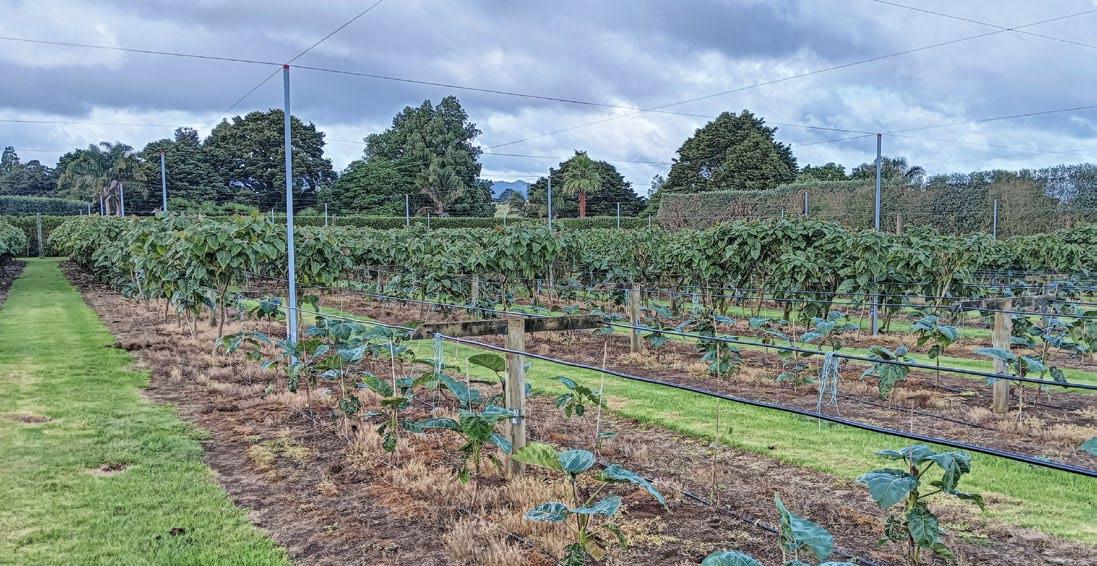

Considering tamarillos on your orchard?
Robyn Wickenden runs a tamarillo orchard at Maungatapere in Northland with Aaron Davies. She is also both the chair and secretary of the NZ Tamarillo Growers Association. HELENA O’NEILL asked Robyn what growers need to know if they are considering growing a tamarillo crop.
450 commercial growers before the mid-2000s when the Liberibacter bacteria came into New Zealand, there are now 24 growers registered with the NZ Tamarillo Growers Association. Of these, the majority are small orchards of around one hectare. Orchards are small because tamarillos are so labour-intensive for maintaining tree health all year round.
“Costs are not automatically scaled with a smaller growing operation. The inputs are mainly labour, fertilisers, insecticide sprays is carried by psyllids), compliance costs and fuel to run the tractor.”
“The cost of employing labour means most tamarillo growers are ‘Ma and Pa’ operations who can dedicate the time to looking after their trees throughout the year,
34 The ORCHARDIST : MAY 2024 YOUR INDUSTRY
with the main labour required during the four-month picking season. The main compliance cost is GAP (Good Agricultural Practice) registration which is the same cost whether you are small or large (incorporating a social responsibility add-on which is a requirement to sell through supermarkets regardless of whether you are employing staff).
“The major capital outlays are a tractor and air blast sprayer to allow for penetration of the sprays, and they must be a certain size to be effective. Frost protection needs to be considered, no matter the size of the orchard. Growers must also be good at maintaining a nursery of replacement seedlings, as these replacements are so frequent.
Tamarillos have a flavour profile like no other fruit. It seems you either love them or hate them
“When it comes to freight, there is a minimum charge for a pallet regardless of how many crates are being supplied on that pallet. Produce has to be taken to the freight depot rather than being picked up. For our Far North growers, this means driving down to Whangārei.”
What about becoming a tamarillo grower?
“For growers enquiring about tamarillos, particularly growers wanting to switch from other crops, please contact the NZ Tamarillo Growers Association before starting to grow tamarillos and get some good advice.
“Our concern is that everyone sees tamarillos as a fast-growing cash crop and starts planting them. If the orchard is not looked after properly, the psyllid will get established in these new orchards and completely wipe out all growers in that area and eliminate this beautiful fruit from the winter fruit bowl.”
What about the diversity of supply?
“Tamarillos have a flavour profile like no other fruit. It seems you either love them or hate them. In a world that has been increasingly guiding consumers’ palates to a sweeter fruit, tamarillos stand out as not being sweet. However, if you have a Laird’s Large variety from a grower who fertilises their trees, I would dispute this.
“Tamarillos still are very seasonal with the peak of the season hitting July or August, although with growers spread around microclimates, the season itself has been extended from April to November. Tamarillos are only picked when they are fully ripe, not coolstored or gas-ripened, so they deliver a flavour profile of freshly picked fruit.
“Diversity of supply provides consumers with an enriched source of nutrition during the winter months.
“There have been several studies done as to the nutritional content and benefits of having tamarillos in your diet. These fruit are full of antioxidants, vitamins C, A, B6 and E, manganese and potassium. Promotion to the consumer of these health benefits comes at a considerable cost, so out of range for a small industry.
“Due to the lack of tamarillos being grown, the secondary market for processed fruit has suffered, with no ‘processing fruit’ price point satisfactory to these processors. We are always receiving enquiries looking for ‘processing grade fruit’ for a huge range of products for example jam, ice cream, cider and chutney.”
PREMIUM HORTICULTURAL IMPORTS NZ LTD

WE SELL:
• Reflective cloth, excellent manufacturers warranty, high UV protection
– From $4500 + GST per hectare based on 3.5m width (1-4m width available)
– Roll length 100m-500m, can be customised within this range
– 24 month delayed payment terms at 0% interest rate on reflective cloth. Conditions apply.
• Orchard platforms from $65,000 + GST, diesel and electric models
• Suppliers of Spanish Fede sprayers and bolt on retrofit towers
• Weed mat
Application machine can also be booked for hire
• Trellis clips for orchards
• Manufacturers warranty on all products
CONTACT:
Simon Easton: 021 312 845 or simon@premiumhortimports.co.nz
Bill Evans: 027 804 7610
Website: https://premiumhortimports.co.nz

THE
TO THE
100% GROWER OWNED AND OPERATED DIRECT FROM
FACTORIES
GROWERS
The ORCHARDIST : MAY 2024 35 YOUR INDUSTRY
Smartomizer, Inverter Qi 9.0 – Fruit Aileron

What were last season’s results?
“We saw the impacts of Cyclone Gabrielle particularly in the Northland area where half our growers are. We also saw several growers call it quits with the prospect of replanting their orchards at their time of life too much to contemplate. Interestingly, all growers are reporting that their tree losses due to Liberibacter, the disease transmitted by the psyllid fly, are right back down to single digits again after hitting us all badly in 2021–2022.
“There was a drop of 18 percent in the tonnage of tamarillos sold through the wholesale markets during the 2023 season compared to 2022; compounded with the previous three years, this has seen the supply shrink by 61 percent after our bumper year in 2019. This further drop in supply had a resultant effect on prices remaining higher.
“Exports continue to decline, but again a higher price is being returned to the grower as the export supply must price competitively with the domestic supply. At this point, we are just trying to keep our export market open until the supply hopefully increases.”
How is this season shaping up?
“Growers are still recovering from the effects of Cyclone Gabrielle and the psyllid population explosion over the last two years, as it takes a tamarillo tree about two years to become productive and four years to reach its peak.
“Indications are that all growers have a good crop on their productive trees, and they are sizing up well.
“We are keeping positive that the weather conditions continue to be favourable and we can supply a reasonable amount of tamarillos to the market in 2024. My guess would be back to 2022 levels.”
Find out more and reach the NZ Tamarillo Growers Association at: www.tamarillo.com
Sales volume (1000kg) 1200 1000 800 600 400 200 0 2008 2009 2010 2011 2012 2013 2014 2015 2016 2017 2018 2019 2020 2021 2022 2023
NZ TAMARILLOS DOMESTIC WHOLESALE SALES VOLUME
36 The ORCHARDIST : MAY 2024 YOUR INDUSTRY
Aaron Davies and Robyn Wickenden, who is also both the chair and secretary of the NZ Tamarillo Growers Association

Season review: Mixed bag for cherries
The 2023–2024 season might have been short and sharp in the South, but cherry exporters in Central Otago say their fruit quality was still very high.
Rain, hail, strong winds and eventually drought –Central Otago cherry growers experienced it all this season, and with that came consequences.
A rogue wind event in spring twisted cherry nets and structures on the Cromwell to Wānaka road, bruising some of the early export cherries.
Central Pac manager Tim Hope says there wasn’t one orchard along that stretch of highway that wasn’t affected; but it wasn’t as drastic as wiping out a full crop of cherries.
Then closer to Christmas came heavy rain that had an impact on fruit right across Central Otago. “It was an average season with similar challenges to past years,” Tim says.
Aimee Wilson
But the cherries that survived were big, and overseas markets recognised that with strong export prices.
“It’s positive that there is still a market for large quality fruit. If you can grow a big firm piece of fruit that tastes good, someone will pay the right amount for it,” Tim says.
Three Kings Orchard managing director Tim Paulin says while they had 20 percent lower volumes this season, he was more than happy with the export prices for his fruit on the new orchard near Clyde. Some of his older variety Lapin cherries sustained some wind damage that took them out of export contention, but other than that it was still a good season, he says.
The ORCHARDIST : MAY 2024 37 YOUR INDUSTRY
Almost 3700 tonnes of cherries were exported overseas this season. Photo courtesy of Central Otago District Council

Almost 3700 tonnes of cherries were exported overseas this season across New Zealand – the majority from Central Otago – a seven percent increase on last year.
NZ Cherry Corp general manager Reece van der Velden says if it wasn’t for the weather the industry would have been close to 6000 tonnes this season.
If you can grow a big firm piece of fruit that tastes good, someone will pay the right amount for it
A fully integrated farm to market company that is family owned by Reece’s father Henry van der Velden and Bob Robertson, NZ Cherry Corp has been immersed in sustainability with its Cherry Rescue Project, that has the ambitious goal to make the entire industry waste free by 2030.
The initiative currently rescues 100 percent of waste grade cherries from four participating orchards, saving
fruit that would otherwise go into landfill, and turning it into new food and beverage products.
Orchards are increasingly having to diversify and find new innovative ways of doing things, as unpredictable weather patterns have continued to hamper grower efforts in recent years.
This season every pocket of Central Otago experienced something a bit different. An intense localised hailstorm over Alexandra missed everywhere else, and anecdotally it was wetter in the Teviot Valley than the rest of the district.
A group of backpackers arriving in Roxburgh in early December say their first job was to strip the trees of the rain affected cherries. It was several weeks before they could start filling their bins with export quality fruit.
Remarkables Orchard owner Sid Birtles, in Roxburgh East, says when you are growing commodity fruit for world markets and competing with Chile that produces 450,000 tonnes, it is always going to be a tough game.
“It’s always going to be a mixed bag, but you can’t give up,” he says.
NZ Cherry Corp’s Reece van der Velden says the company uses their cherry waste for a range of new by-products.
Photo by Richard Langston, Country Calendar
38 The ORCHARDIST : MAY 2024 YOUR INDUSTRY
“It’s such a big investment to keep our quality right up there.”
Central Otago cherry growers experienced it all this season
Clyde Orchards manager Kris Robb says average yields were down on pre-season predictions, “but the overall tonnage for exports was promising for the future.”
He says given the expansion and development of cherries across the wider Central Otago district in recent years, 4000 tonnes is still well short of what was expected in the local industry.
Describing the season as shorter and sharper than previous years, he says the fruit size and quality on his orchard was strong, and the pack-outs were outstanding.
“The market returns were strong, so if you weigh that all up, we worked a lot harder in previous seasons to pack less fruit.”
Clyde Orchards produces Picnic cherries that are among the first export variety to hit the overseas market out of Central Otago – in early December.
Back up in Cromwell, Suncrest Orchard owner Michael Jones says his crop was similar in size to 2022–23, and the front part of the season, in particular, was very light.
Three days of rain over the pollination period affected the first crop of cherries, but then over December to January it was the other extreme with very little rain at all.
...if it wasn’t for the weather the industry would have been close to 6000 tonnes Almost 3700 tonnes of cherries were exported overseas this season

“And what rain we did have we needed.”
Always an optimist, he says the reality of being a grower is you have to contend with everything mother nature throws at you.
“There is just a misconception that every season is going to be the perfect bumper crop, but we just haven’t had that.”
The last time anybody talked about bumper crops was back in 2017 – years before Covid-19 hit, then staffing issues became a concern through the pandemic, and now this season some orchards reported waiting lists of workers wanting to pick fruit.
“We had plenty of staff, and good quality staff, so we weren’t struggling to fill the positions. The logistics were also hunky dory and there was no worries about getting the fruit out of the country,” Michael says.
In our world of twigs and roots pedigree is everything.

As we all know, in the fruit growing industry ultimately everything stems from a twig. We have alliances with some of the world’s best new fruit variety developers and rootstock breeding programmes. These relationships and our continual search for the best cultivars puts us at the forefront of global variety and rootstock development in New Zealand.






Our unique capability across a wide variety of crops and our focus on matching varieties and rootstocks to conditions allows us to offer real, informed advice. Call: Grant Bryan, 0274 201 003, grant.b@waimea.group Kate Marshall, 0274 201 033, kate.m@waimea.group


www.waimeanurseries.co.nz
0 1000 2000 3000 4000 5000 6000
The ORCHARDIST : MAY 2024 39 YOUR INDUSTRY

Secondary markets and reducing food waste
In today’s economic conditions, finding the balance between healthy affordable fruit and vegetables and providing growers a living is proving more challenging than ever. New Zealand’s food security is becoming a hot topic in homes across the country, but there is no silver bullet answer. HELENA O’NEILL takes a look at the role growers are playing through secondary markets and grower food aid.
Angus Simms and Katie Jackson are the founders of Wonky Box, a business created from a determination to not only focus on how to reduce food waste at its roots but also increase access to nutritious food.
Angus says Wonky Box has been embraced both by growers and customers alike and has played a pivotal role in bridging the gap between them.
“Growers appreciate how we recognise the effort and quality put into every crop, ensuring that produce outside traditional specifications still reaches consumers. Our partnerships allow growers to maximise the value of their resources within the farm gate, preventing wastage of perfectly good food.”
Consumers can appreciate the opportunity to access fresh, nutritious produce at a budget-friendly price point, Angus says.
“Secondary markets can be incredibly important for growers for several reasons: They provide an outlet for produce that may not meet strict export or retail standards but is still perfectly good for consumption. There could also be a bumper crop or a flush on, meaning there is simply too much of a product than any one grower could sell to a single market.”
Horticulture New Zealand environmental policy advisor Emily Levenson says food waste and food loss are inefficiencies in the food system when food is grown and processed but doesn’t get matched with someone to eat it or another valuable end-use.
“The horticulture industry is interested in reducing food waste, especially through selling products made from the discarded parts of the plant or produce that doesn’t meet strict supermarket or export specifications.
40 The ORCHARDIST : MAY 2024 YOUR INDUSTRY
Katie Jackson and Angus Simms are the founders of Wonky Box
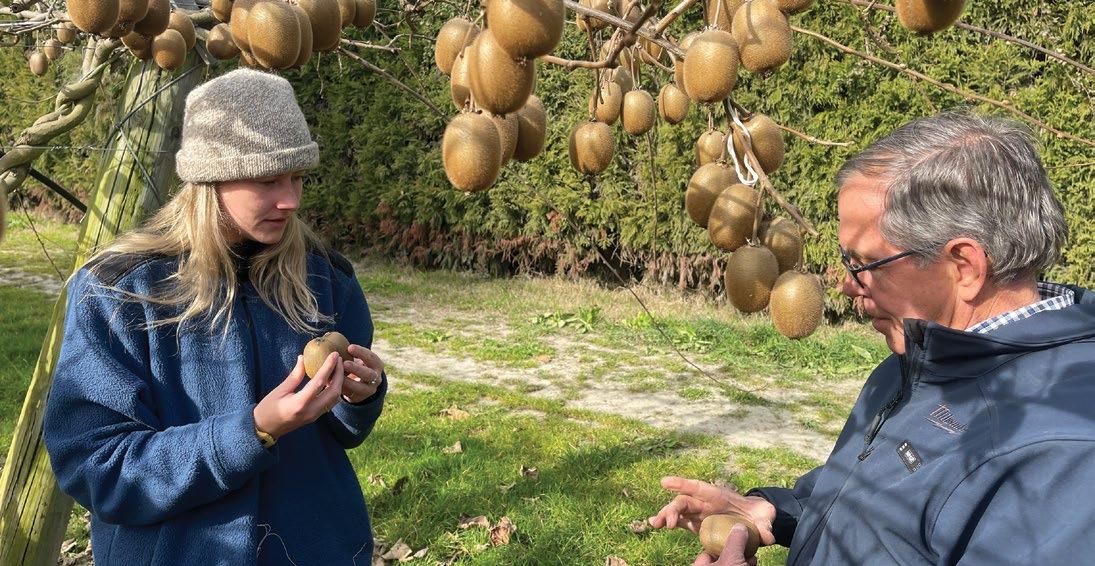
“For example, Eden Orchards in Central Otago produces cherry juice from the cherries that can’t be exported or sold domestically. Lots of produce may not have a market through traditional channels if it’s the wrong size, shape or colour.”
The biggest challenge is increasing consumer demand for ‘odd’ produce
Emily says that secondary markets like ‘wonky’ produce boxes can make sure consumers still have the option to
buy that produce, while growers are still compensated for all of the hard work, labour, time and inputs they expended to grow those fruits and vegetables.
“Currently, most ‘lost’ fruits or vegetables are donated or sold to farmers for animal feed, returning those nutrients to a different production system.”
The biggest challenge to repurposing fruits and vegetables that would otherwise be lost is increasing consumer demand for ‘odd’ produce and the research and development required to generate new value-added products, she says.
Gisborne orange growers Bron and Sandy Kemp run Twisted Citrus, which sells fruit boxes, picked to order, direct from the orchard.
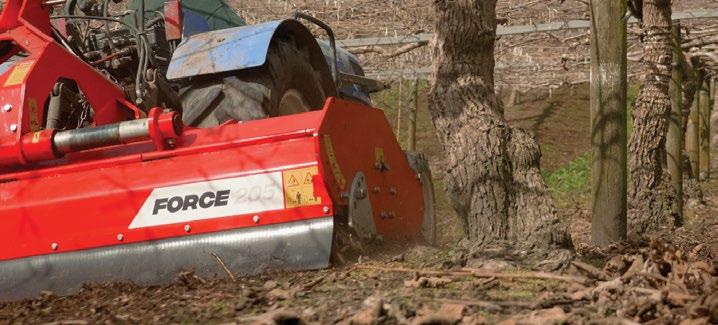 Wonky Box co-founder Katie Jackson meeting with orchardist Hugh Findlay from Cherry Gold Orchards in Hawke’s Bay
Wonky Box co-founder Katie Jackson meeting with orchardist Hugh Findlay from Cherry Gold Orchards in Hawke’s Bay
The ORCHARDIST : MAY 2024 41 YOUR INDUSTRY
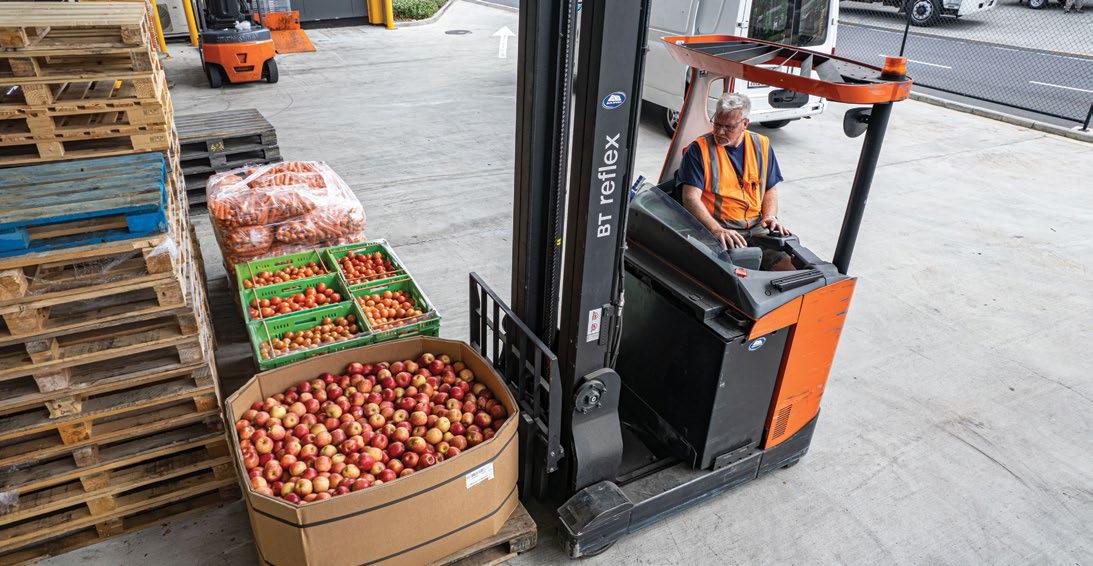
Grower donations arrive at the New Zealand Food Network warehouse in Auckland, where lead hand Ken Hart readies the produce for distribution
Twisted Citrus has also embraced the secondary market, offering “imperfect seasonal boxes”, director Bron Kemp says.
“We don’t want any produce that we purchase from our growers to go to waste. While packing our premium fruit and gift boxes we always do come across fruit that is second grade – this fruit is used in our imperfect seasonal boxes.”
Twisted Citrus also dehydrates some fruit and sells it as a value-added product. The rest is donated to a local initiative Gizzy Kai Rescue and any produce that is past its best is given to a local farmer’s pigs, Bron says.
“I think every grower wants or needs to find fruit markets that do not comply with the premium grade market. There is nothing worse than seeing fruit go to waste on your orchard.”
Finding the balance of providing access to healthy, affordable fruit and vegetables while also providing growers a living is difficult to achieve.
“I know many local fruit growers who struggle to make any significant profit from their produce at present – even when the product is premium grade. This is due to recent weather events, and also the costs associated with growing produce and employing staff have gone up significantly, while the price returned to the grower has remained much the same – there just isn’t much money left over unfortunately.
“I do think having a market for second-grade produce helps reduce the cost for the end consumer, but the price returned to the grower still needs to cover their costs [in order] for it to work.”
Another way of reducing food waste is in the form of grower aid, donating produce to organisations like the New Zealand Food Network (NZFN) and KiwiHarvest.
T&G became a foundational partner of NZFN in 2020, says Adrienne Sharp, Head of Corporate Affairs, T&G Global.
Having a market for second-grade produce helps reduce the cost for the end consumer, but the price returned to the grower still needs to cover their costs
“For many years, we’d directed our surplus fresh produce to food hubs and charities in our local communities but what we’d struggled with was having the ability to efficiently move bulk produce beyond the communities where our operations are,” she explains. “NZFN’s model solves this challenge and together with their private, social and government partners, they’re playing a pivotal role in helping get food to where it’s needed most.
“Last year, T&G, together with our growers, donated 876 tonnes of produce to NZFN – which means we’ve donated about three million kilograms of fruit and veges since we first partnered with NZFN.”
The Supreme Sikh Society of New Zealand based in Takanini, South Auckland, is one of New Zealand Food Network’s 63 food hubs across the country.
42 The ORCHARDIST : MAY 2024 YOUR INDUSTRY
Project manager Daljit Singh says that when the lockdown was imposed in February 2020, the society opened its doors to support the community to the best of its capacity.
“Initially serving primarily Indian recipients, we soon found ourselves aiding a much broader demographic, providing food to 3500 families daily.”
The society’s operations expanded to various locations including North Shore, New Lynn, Huntly, Ngāruawāhia, Tauranga, Rotorua, Hastings, Wellington, Queenstown, and Christchurch, with 95 percent of recipients from the wider community.
“With the support of Sikh growers from Te Puke, Hastings and Pukekohe, we were able to distribute 12 tonnes of food daily. Our efforts were recognised when we were nominated for the NZ Food Heroes award, which we proudly won.”
“We partner with organisations to deliver initiatives that focus on the education setting, including Oke Charity which offers vegetable gardening in schools, Life Education Trust and the Two Raw Sisters which run cooking workshops in schools, Stars Netball and the Stars 5+ Day Schools Club linking healthy eating with physical activity, and the Fruit in Schools programme which provides education resources that support fruit and vegetable consumption, including sustainability.”
Reduce food waste by encouraging Kiwis to eat more fresh fruit and vegetables
Daljit says the society joined NZFN in December 2020, covering from Huntly to Henderson in West Auckland.
“We are fortunate to have a network of 20 to 40 growers from Pukekohe, Tauranga, and Hastings who have been supporting us with food donations. Many of these growers have known me personally for two to three decades. When we announced our initiative to support the wider community with food parcels, their support increased significantly.”
While they were already assisting before the project’s expansion, grower contributions grew even more, Daljit says.
“Among these growers, there are four or five individuals who have become our backbone, consistently supplying us with the food we need to serve the community.”
On a national scale, KiwiHarvest chief executive Angela Calver says KiwiHarvest collects produce from 83 supermarkets daily, working with 44 growers or produce businesses in the last year.
“We are also focussed on ensuring that we are working with recipient agencies who value the food that we donate to them and that they are working on helping people break out of the situation they find themselves in by offering other wrap-around services, not just providing food.”
Angela says the top three reasons for KiwiHarvest receiving food are that it is nearing its best-before date, is damaged, or is oversupplied, in that order.
Another aspect of reducing food waste is ensuring that New Zealanders eat more healthy fresh fruits and vegetables.
Thirty years ago 5+ A Day was launched by United Fresh NZ Incorporated as an advertising campaign to encourage Kiwis to eat more fresh fruit and vegetables for good health.
Project manager of 5+ A Day, Carmel Ireland, says the campaign has come a long way since its inception in 1994.
In 2007, 5+ A Day became a charitable trust and continues to work to encourage the consumption of fresh fruit and vegetables.
United Fresh runs the governmentfunded Fruit in Schools programme, with members such as MG and T&G helping to distribute over 27 million servings of fresh fruit and vegetables to over 120,000 children and school staff at 566 schools in 21 regions.
Carmel says they also partner with product groups and organisations to target consumers with promotions and campaigns to drive consumption.
“Currently we are working with Vegetables NZ on the Add One More Vegetable promotion, Citrus NZ to promote all varieties of citrus throughout 2024 and the Persimmon Industry Council to promote the upcoming persimmon season.”

The ORCHARDIST : MAY 2024 43 YOUR INDUSTRY

With Steve Weatherell (right), Gisborne branch manager Paul Barker (left) says: “We’re proud of what we do but there are challenges, like the roads, and keeping that cool-chain intact, as with produce there is no room for error.”
Road freight still best option
Thirty years after founding their Gisborne-based trucking company, Steve and Jane Weatherell remain focused on making sure food always gets through.
Kristine Walsh
Like a fleet of giant overnight couriers, a Gisborne trucking company gets fragile produce to market in uberfast time, but there are challenges in doing so.
“The reality is the roads out of our region are always going to be vulnerable, especially with the increasing number of big weather events, and there’s no way around that,” says Freshways (formerly Weatherell) Transport owner Steve Weatherell.
“But though we’ve experimented with different transport options, road always comes out on top, so we just work with what we’ve got.”
This year marks the 30th anniversary since Steve and his wife Jane founded their company, and food – particularly fresh produce – has always been their primary focus.
That’s been a big strength for an outfit operating out of one of the most prolific food-producing regions in the country. On the flip side, time is of the essence: a driver can’t park up for a couple of days while an issue with roading gets sorted.
“That was a big problem immediately after Cyclone Gabrielle (February 2023) … the roads were closed both north and south even though we knew we could get through,” says Steve. “So we had to impress upon the authorities that it did not just stop food from getting out, it also stopped it from getting in, and we had a community that needed feeding.”
The impact of Cyclone Gabrielle was just the latest in a series of impacts Steve has witnessed since 1994 when he founded Freshways with a handful of trucks, building it up to a leading provider with six depots nationwide, over 150 staff (plus contract workers), and more than 100 trucks (plus 20 owner-drivers) clocking up over one million kilometres every month of the year.
Being based in Gisborne means their drivers are travelling some of the most vulnerable roads in the country.
“The moment our drivers get over the Wharerātā Ranges and through to Napier in the south or through the Waioeka Gorge to the north, the journey gets a whole lot smoother,” Steve says.
44 The ORCHARDIST : MAY 2024 YOUR INDUSTRY
“And it’s even more marked in the South Island. All the damage inflicted by sub-standard roading on our trucks, trailers and refrigeration equipment just doesn’t happen there. It’s like night and day.”
Over the years Steve has supported other transport options in an effort to get the best results for producers of fresh fruit, vegetables and meat.
Between December and March this year was huge for stonefruit with eight to ten trailer loads coming from Cromwell to Picton every day … the season was that good
Before the Gisborne to Napier rail line was mothballed – most likely for good – he tried that, but the scheduling didn’t suit clients who often didn’t know what they had to shift until the day of transport.
Then he got behind Eastland Port’s ‘blue highway’ trial of coastal shipping, but that didn’t work either.
“Because of the challenges of Poverty Bay (Tūranganuia-Kiwa) the ships were stuck offshore every time there
was bad weather, and you just can’t have that with fresh produce,” he says.
“Clients were having to organise trucking on the fly to get produce off the wharf and on the road, so there was some resistance.”
So it was back on the road which, says Steve, has challenges of its own.
“All we want to see is good, practical work done to make sure drivers have a safe, consistent pathway to and from our region.
“Nobody is interested in fancy flyovers and the like. We just want quality, well-maintained roading.”
Even given the challenges with roading, Freshways manages to keep a big operation on the road.
Seven days a week the drivers are looping the North Island – from Gisborne down to Wellington, up to Auckland and home (or the other way around).
And most days the company has around half-a-dozen trailers on the inter-island ferries – each way – to get fresh produce to the South Island.
“People don’t believe we can leave Gisborne late in the afternoon and have the goods on the shelves in Invercargill
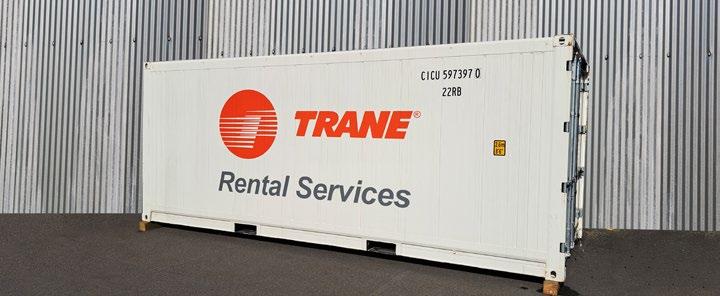


What you need, when you need, for how long you need, with full service support. The perfect solution for the season. Cool or heat it! Hire a Trane Refrigerated Container for Temporary Cooling or Heating Requirements Gary Morris Phone: 0272 836 949 Email: gary.morris@tranetechnologies.com For all temporary refrigerated containers or water chillers to suit your needs. Call us today. www.trane.co.nz The ORCHARDIST : MAY 2024 45 YOUR INDUSTRY
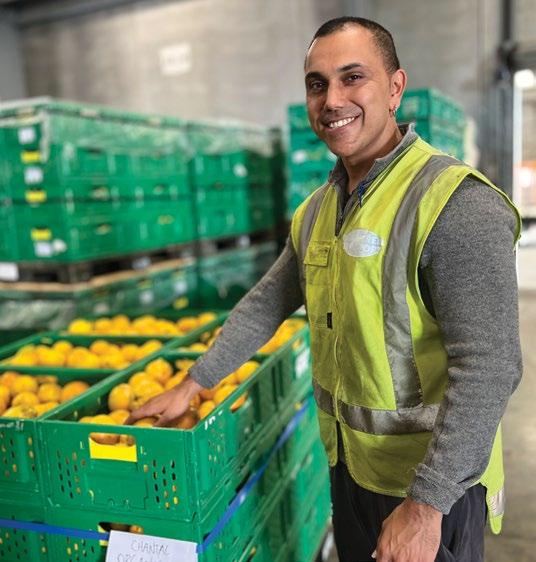
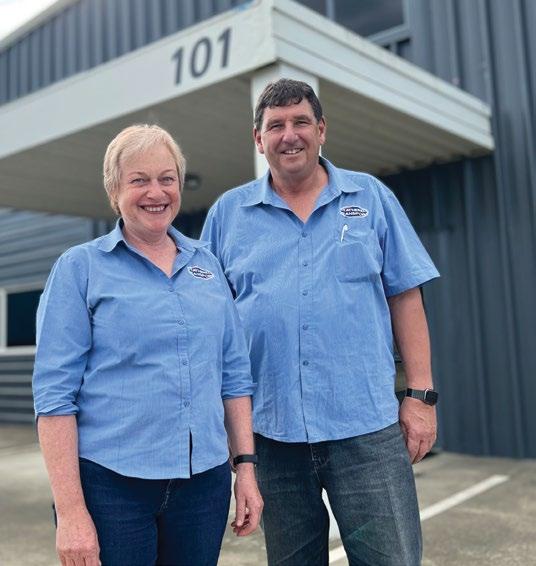
This year marks the 30th anniversary since Steve and his wife Jane founded their company
by the following day, but that’s what you need to do when working with fresh produce.
“It is critical to all our clients that they get maximum shelf life and – within the boundaries of legal and safety issues – we pull out all the stops to do that for them.”
Steve’s commitment to carting produce was the very foundation of his business.
A former owner-driver himself, while living in the Bay of Plenty in the early 1990s he drove the Gisborne run for Freightways.
“Other drivers said they didn’t want to deal with ‘that bloody gorge’ on the north side and the hills to the south, but I thought it was better than being stuck in traffic all day, so I just got into it.”
Steve continued with the run when it was taken over by Mainfreight but found growers were more interested in connecting with him than the company, so he formed his own.
“By that time the Kaiti freezing works had closed, along with the local pet food factory, so a lot of workers moved into horticulture and the industry was getting bigger and bigger.
“Some local growers had asked if I’d consider going out on my own, so in October 1994 we talked about it over a few beers at the Hika (Waerenga-a-Hika Hotel, now Bushmere Arms), and the next day I was in business.”
While roading has presented challenges over the years, it’s not the only hurdle Steve and Jane have tackled.
“Our business is fresh and frozen produce so we’re always going to get through one way or another … people need food.
“There certainly were big costs to face after the cyclones. Road closures meant we had to drive south before we could go north and that required more trucks and more drivers.
“Our biggest hit, though, came later in the year when it just wouldn’t stop raining. That hindered growers’ ability to produce and pick crops so, from August to October, volumes were way down and we had a lot of trucks coming into Gisborne with loads then having to go out empty. That was a huge cost to us but we couldn’t not do those in-bound loads. Our community needs food.”
Continuing rain affected the roads too, but Steve says things are looking better after a dry summer.
“They had a hell of a task to deal with all the weatherrelated damage but if you look at it now, particularly in the Waioeka Gorge, there are big tracts where they’ve dug it out, rebuilt it and laid new seal,” says Steve.
“Our drivers can really feel the difference so what we need to see is more of that, where and when it is needed.”
Steve Weatherell qualified for his Gold Card this year and while he doesn’t know what he’d do if he actually retired, rebranding as Freshways is part of the move towards that.
“Jane and I thought that, at some stage, it would be odd to have our name on all these trucks, so that’s what drove the rebranding,” he says.
“Plus, it really sums up what we do … finding ways to get fresh produce to market in good time and in good condition.”
30 46 The ORCHARDIST : MAY 2024 YOUR INDUSTRY
In charge of dispatch, TJ Singh manages a hectic work programme of truck movements, spanning the length and breadth of the country

us your nominations for

Industry Awards
HortNZ is calling for nominations for its 2024 Awards to be presented at the Horticulture Conference Gala Dinner.
HortNZ will present up to one award in each of the following categories each year.
BLEDISLOE CUP
Awarded for an outstanding and meritorious contribution to the New Zealand horticulture industry.
PRESIDENT’S TROPHY
To celebrate and develop inspiring leadership within the horticulture industry.
INDUSTRY SERVICE AWARD
To recognise people with long and dedicated service in a supplier or service role (not a grower) that have worked beyond the call of duty for the betterment of the horticulture industry.
ENVIRONMENTAL AWARD
To recognise a person, or organisation, that has developed and implemented a sustainable environmental project, with identifiable benefits.
HORTNZ LIFE MEMBER
To recognise growers with long and dedicated service as office holders of HortNZ and/or an affiliated Product Group or affiliated Grower Association.
Full criteria for the above awards are available on the HortNZ website or can be requested from the Board Secretary by emailing admin@hortnz.co.nz
Who can make nominations?
• Any grower member of HortNZ, an affiliated Product Group or an affiliated Grower Association can make nominations.
How do I nominate someone?
• Complete the nomination form on the HortNZ website www.hortnz.co.nz/news-events-andmedia/events/industry-awards/. If you have any questions about making a nomination you can email admin@hortnz.co.nz or call 0508 467 869
When will the awards be presented?
•At the 2024 Horticulture Conference Gala Dinner on Thursday 29 August 2024 at Mercury BayPark, Mt Maunganui
When do nominations close?
• Nominations must be submitted via the online form on the HortNZ website by 5.00pm on Thursday, 25 July 2024.
Send us your nominations now!
Send
202
the
4 Horticulture

No growth without infrastructure
Mike Knowles, chair of the New Zealand Council of Cargo Owners (NZCCO), says the future of horticulture in New Zealand depends on a renewed focus on making our own domestic supply chain as efficient as possible with improved port productivity and making much needed investments in infrastructure to support this.
What is the state of New Zealand’s supply chain infrastructure?
“The global supply chain has suffered a number of shocks in recent years which have caused massive disruption around the world. Apart from the pandemic that really disrupted containerised shipping especially, you’ve got the two major shipping canals operating below capacity: Panama is coming right now but Suez is facing the geopolitical issues going on in that area. Now a container ship has taken out a key bridge in Baltimore, which will have a ripple effect as ships divert to other ports. These shocks are going to keep coming though, and they’re outside of our control. We need to control what we can control – focussing on having the most efficient domestic supply chain possible to make us competitive in our markets.

“We’ve become an expensive country to do anything in with costs rising everywhere. NZCCO believes there is room for improvement in the New Zealand port performance and productivity. Fees are going up, up, up but we’re not seeing any sort of return to the productivity that existed before Covid-19, bar at a couple of ports.
“Port of Auckland (POA) is a vital cog in the national supply chain, because it’s the main import destination and first port of call. So what happens at POA impacts the rest of the supply chain, if the ships get delayed in Auckland or cannot discharge/load all their cargo, this disruption flows on to the next ports of call for the ships. So POA working efficiently at a good productivity level is important for the whole country.”
Inland hubs like MidlandPort in Rolleston, which has daily rail to Lyttelton, are of vital importance to prevent port congestion.
48 The ORCHARDIST : MAY 2024 YOUR INDUSTRY
Photo courtesy of LPC
Are shippers concerned by talk of privatising Port of Auckland ownership?
“There is a lot of chatter that costs will go up under a private port operator but costs are already going through the roof now under Auckland Council ownership. POA has already signalled the cost increases to come for the next five years, and other ports in New Zealand will be looking at what increases they are achieving. So we’re asking, how do we get them working more efficiently with infrastructure kept modern and current? I mean just in Auckland you’re probably talking about $700+ million required for new infrastructure and replacement over the next 35 years to keep it running. Is the council going to make that investment?
In Auckland you’re probably talking about $700+ million required for new infrastructure and replacement over the next 35 years to keep it running
“So we’re not averse to having a professional operator bringing their global expertise in running ports and terminals, with the appropriate KPIs around achieving certain productivity levels and reinvesting in the port infrastructure to keep it at the leading edge. A lot of people are jumping up and down about it, but you’re not selling the land, you’re selling the rights to operate the port and terminal. It’s a common model all around the world where the council or local government owns the port land and rents it out to professional operators. There will be lot of interest from the big international operators, and having that professional experience will have its advantages.”
Is lack of infrastructure investment holding back growth in horticulture?
“The consenting process for new infrastructure under the RMA (Resource Management Act) has been very challenging and has impacted the country negatively for many years now. I know the new government is trying to speed it up, but the RMA has been chronic with all the delays. The classic case in point is waiting six years for the Port of Tauranga simple berth extension and we’re not even there yet. We’re talking about critical infrastructure for the country’s biggest port to allow it to grow its capacity. Horticulture has a lot of growth coming in the next five to ten years, so we are concerned about how the port can function.”
Are roads king or will coastal shipping have a future role in inter island freight?
“Cargo will always flow the most efficient way. And road transport is more efficient at the moment –cheaper, quicker and more direct. Our roads are very important for moving domestic produce around. There’s some momentum now with the Roads of National Significance returning under the new government so some investment might actually happen.
“There is definitely a role for coastal shipping. We’re going into this era of decarbonisation including for shipping. The alternative fuels for ships are not as energy dense as heavy fuel oil so they require much bigger fuel tanks to allow the ship to steam the same distance, so ships will need to be that much bigger to be viable. We will see much bigger ships in the future than are coming to New Zealand now for that reason. And they won’t be going to every port in New Zealand.
“We see a future where it’s probably going to be a threeport strategy for these bigger ships. So Auckland for the imports and Tauranga for the imports and exports. And one other in the South Island, probably Lyttelton. Coastal shipping will have a key role in moving freight to these three key hub ports, and the other ports will still exist but as feeder ports. It is important that they do continue to operate as feeder ports to provide resilience for the country in the event of a natural disaster.
“When you are talking about the supply chain between the North and the South Island, the ferry services are a critical link, no doubt about it, including produce going both ways. We are concerned about the costs and definitely want to see at least two independent commercial operators on the Cook Strait to provide competition. Coastal shipping could also be a solution for this, but it does need to be cost competitive as well.
The classic case in point is waiting six years for the Port of Tauranga simple berth extension and we’re not even there yet
“Rail is a factor, too. The inland hubs are really important to keep the cargo moving so ports don’t become congested. Port of Auckland out to Wiri, Tauranga out to Ruakura, and Lyttelton to MidlandPort in Rolleston. However you connect them – road or rail – we need goods coming in and out moved quickly and efficiently. Safeguarding the freight corridors in and out of the ports to allow this to happen is of national importance.”
The ORCHARDIST : MAY 2024 49 YOUR INDUSTRY
TECHNICAL
THE LATEST INNOVATIONS AND IMPROVEMENTS
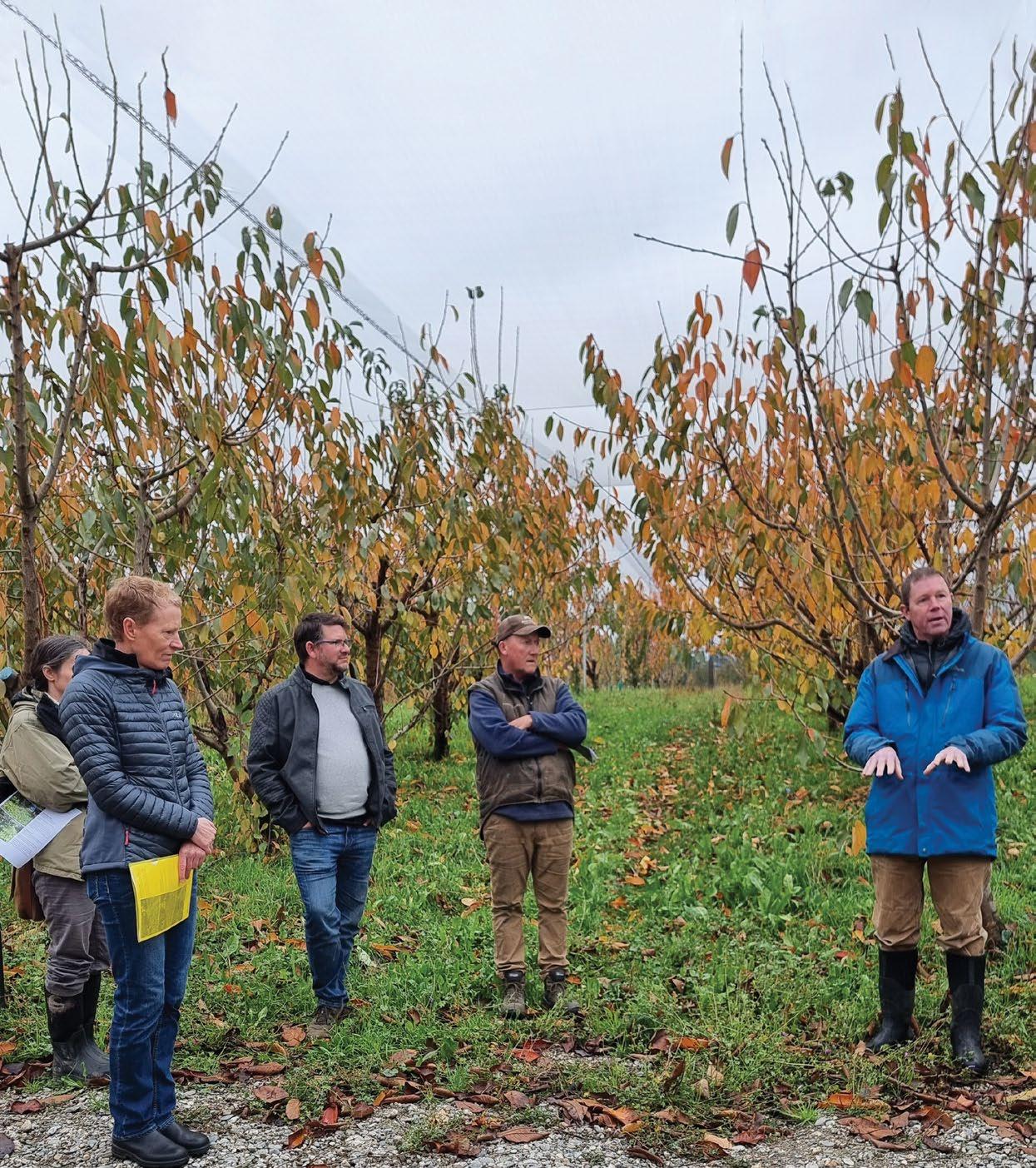
Summerfruit NZ hosted a field visit at the Affleck orchard in April to share learnings from the project over the growing season.
Pictured (from L to R) are Sally Anderson, Summerfruit NZ research and development manager, Dr David Pattemore, of Plant & Food Research, orchard owner Craig Affleck and Dr Charles Merfield, consultant
Summerfruit understorey project
Insect abundance increasing by two-thirds and the mower staying in the shed are two of the benefits seen in the first year of a Summerfruit NZ and A Lighter Touch understorey planting project.
Gina Jewell : A Lighter Touch programme
The project aims to establish understorey planting in summerfruit orchards to enhance biodiversity and is looking at associated co-benefits. These include weed management, improved botrytis disease control through covering bare ground, and improvements to soil health.
Summerfruit NZ technical adviser Richard Mills says the project is leveraging knowledge gained from the A Lighter Touch (ALT) Biodiverse planting in perennial crops project, where beneficial planting was established in two Gisborne citrus orchards to enhance biodiversity and natural predator populations.
“Summerfruit NZ looked at that work and thought, there’s something we could learn from here, and trial with our growers. The A Lighter Touch support has been invaluable in getting the summerfruit project underway, both the financial contribution, and the technical resource that investment enables.”
While the project is first and foremost an understorey agroecological project, Richard says Summerfruit NZ is particularly interested in the associated co-benefits.
“The ability to grow more and get some more organic matter in the soil is just huge, particularly in Central Otago. In Hawke’s Bay we might have organic matter levels naturally of about five percent, whereas in Central Otago, to get to two percent in places is a big ask.
“The more organic matter in the soil, it’s going to hold on to nutrition, it’s going to hold on to water and slow the percolation through the soil. If you can hang on to water instead of it flowing across the top, that’s a big benefit.”
The Summerfruit project involves four orchards in Central Otago and one in Hawke’s Bay. The first understorey was sown in a Roxburgh apricot orchard in April 2023, followed by a Cromwell cherry orchard in September. The remaining three orchards are scheduled to plant their understorey in April.

The understorey in the first orchard planted as part of the project, an apricot block at Fairview Orchard in Roxburgh. Pictured is the understorey in February 2024, ten months after planting, having come through a management season with vigour.
by Kate Colhoun
A mix of 17 beneficial annual and perennial species was planted at the initial two orchards, with the species mix used for the ALT citrus project being adjusted to suit Central Otago growing conditions.
Over the past summer, research associate Kate Colhoun of Plant & Food Research has been a fortnightly visitor to both orchards, monitoring the understorey and conducting insect sampling.
From October Kate has noted which plants have established, when they are flowering, and whether any other plants not in the seed mix have grown. In November insect monitoring started, using a sweep net to collect samples at five points in the understorey. Insect samples were also taken from other parts of the orchard not part of the project, to provide a comparison.
The results have been clear-cut. In one orchard, 2500 insects had been recorded in the understorey across a three-month period, compared to 1500 in the control area of the orchard.
Kate says the amount of flowering material in the understorey is a key factor in attracting one-and-a-half times more insects, many of which are beneficials, such as tiny parasitoid wasps, lacewings, ladybirds, predatory mites and hoverflies.
“All these little parasitoids and hoverflies, the adults feed on those flowering plants, but they have a special insect they need for reproduction. It’s at the reproductive stage they need a host insect to feed on, such as leafroller or other insect pests in the orchard.”
The ORCHARDIST : MAY 2024 51 TECHNICAL
Photo

Non-flowering plants also play an important role in providing shelter to boost and maintain the population of beneficial insects to attack pest insects. New Zealand agroecologist Dr Charles Merfield, who researched the plant species selection for the ALT citrus project, emphasises the need for biodiverse planting to provide not only flowering plants as sources of nectar and pollen for beneficial insects, but also plants which provide refuge – protection for beneficial insects from their predators, and shelter year-round.
With results to date demonstrating the understorey planting is enhancing the insect population and diversity, “the next step is to establish does that mean more parasitism of orchard pests, are we seeing the crop protection benefits?” Kate says.
Richard Mills is considering how future orchard management practices could change with a better balance of insects –“more predators, less prey” – or in simple terms, more good insects, less bad insects.
“The obvious example is aphids, which can be a problem in stonefruit orchards. They’re lovely juicy prey for every predator insect to chew on, and they’re generally slow moving. By creating a place in the orchard for beneficial insects to live, and food for when there’s no aphids around, can we ultimately reach a place where we don’t have to spray for aphids anymore?”
Cromwell orchardists Georgie and Craig Affleck have planted half a hectare of their cherry orchard as a demonstration block for the project. They are particularly interested in the soil benefits, with some parts of their orchard being very poor soil – “there’s no organic matter at all.”
Georgie and Craig previously farmed a mixed cropping, sheep and beef property in northern Southland, and had seen benefits of regenerative planting through work they had done with Mainland Minerals. When Summerfruit NZ told them about the understorey project, they jumped at the opportunity to be involved.
About half of their block is heavier soil and the remainder is the stoney, gravelly soil they are looking to improve. They planted the understorey using vineyard equipment to cultivate and sow the seed between the rows, and a hand spinner underneath the trees where the machine wouldn’t fit.
“Ideally you’d plant your understorey before you planted the trees, but even in the areas where I couldn’t cultivate, where I’d just sprayed off the ground, the seeds on top still germinated. You’ve just got to mix it in,” Craig says.
Despite the Afflecks’ soil differences, the understorey established in both. The more stoney soil was a bit slower, not as thick, and dried out more quickly – not unexpected given the soil type.
“It’s been really exciting to see what has come through, and the growth. It looks a lot more lush than grass growing in the rows, and it looks and smells a lot better,” Georgie says.
Another bonus has been savings on diesel and mowing.
“We haven’t mowed it at all this year,” Craig says. “At harvest I just rolled it, which flattened it down enough for the pickers with their ladders. There were no complaints from them.”
As the cooler months roll around, the understorey will die down and be mulched into organic matter, creating the layer of compost supporting the understorey to self-seed and regenerate.
Craig did need to use a line trimmer to cut the understorey back around the sprinklers, as it was restricting the water distribution. He sees this as a lesson from the project, saying while he would be happy to plant the understorey in the rows across the entire orchard, the under-tree management needs further consideration.
Richard Mills agrees, with ideas discussed including weed spraying around the sprinklers, or raising them on a stake to better enable water dispersal. Understanding how management practices need to adapt to accommodate understorey planting is another of the project’s objectives.
“We’ve got 17 species in the seed mix. The first step is about learning which ones establish in which environment. In the future we may find we have three species that go in what was the herbicide strip under the trees, and three completely different species that are sown down the middle.”
Already, the project has seen differences in how the seed mix establishes geographically. At Richard’s home orchard near Hastings he planted some 20m by 5m trial sites 18 months ago and has been comparing his results to those seen in Central Otago. In Richard’s plots species like chicory and plantain have established far more quickly and essentially dominate, smothering out the other plants.
52 The ORCHARDIST : MAY 2024 TECHNICAL
The understorey at the Afflecks’ cherry orchard at Cromwell six months after planting, holding up well having gone through a management season, including spraying and picking. Photo by Kate Colhoun
In Central Otago the plant species established more evenly, naturally changing through the season. “At the start, the phacelia comes through quite fast, and the coriander started flowering early, along with the alyssum and some of the other annuals like chickweeds. As the season went on, the clovers really came into their own, followed by the grasses,” Kate says. However, the grasses established differently in the two Central Otago orchards.
To do something different will require a mindset shift, and maybe some machinery shifts as well
“At Roxburgh the grasses grew really well. There was beautiful cocksfoot and ryegrass, then timothy and the fescues as well. At the Afflecks’ orchard (at Cromwell), there wasn’t as much grass establishment, but there was lots of good clover, particularly the strawberry clover and the white clover.”
Richard says this learning is exactly what the project is about. “We found in Hawke’s Bay chicory is not a good choice. In Central Otago we may find there’s something else that doesn’t work. The seed mix will probably alter as the project progresses.”
The longevity of the understorey is also key. “We need to mimic what happens in a standard orchard. When you plant a new orchard you put a grass sward down, and you never redo that for the life of the orchard, for 15 or 20 years. It’s going to get thinner and it’s going to get weedier.
“With this project we need to find a management system that doesn’t need replacing very often. Is that ten years or 15 years, or the life of the orchard? We need to keep the understorey healthy enough and the sward thick enough that it doesn’t get overtaken by giant mallow or hemlock or other weeds.”
Over the next two years the project will be looking to see which plants have established in the shade, and which are happier in the more exposed, sunny environment, as well as comparing plant growth in the two regions.
Sharing knowledge from the project is also important. Summerfruit NZ held a field visit at the Afflecks’ orchard in April, and will provide further information at grower events in Hawke’s Bay and Central Otago in October.
Richard is keen to see grower groups establish to share knowledge and experiences. “For many of us old-school orchardists, we’ve only ever known the bare dirt under the trees, the herbicide strip. To do something different will require a mindset shift, and maybe some machinery shifts as well.”


© Copyright 2021 Farmgard Ltd. All rights reserved. Specifications are subject to change without prior notice. CONTACT US NOW TO FIND OUT MORE. Berti offers the best mulcher for the finest mulch. They have double internal counter combs which reduce prunings to a very fine mulch. The finer the mulch, the less chance of disease. AN ALL ROUND
Get the finest mulch with the Berti orchard mulcher. CALL FARMGARD 24 HOURS 0 800 FARMGARD FIND OUT MORE AT farmgard.co.nz Nationwide Dealer Service Network 35 years, Generations of Experience The ORCHARDIST : MAY 2024 53 TECHNICAL
FINE MULCHER.
Figure 1 : Accumulative GDDs by month for the past five seasons in Twyford, Hawke’s Bay, New Zealand. Source: MetWatch
2024 season in review
At the time of writing, we are heading into the last few weeks of the 2024 pipfruit harvest. Generally, fruit size is less than optimal this season in pipfruit and Hayward kiwifruit, with the curveballs in the North Island of poor conditions in the early part of the pipfruit growing period, and the drought in Nelson, influencing final fruit size.
Jack Wilson : AgFirst
Fruit quality however, is excellent across the fruit sector, which is largely down to the great weather we have recently experienced. Tree health was an unknown for many growers going into this season following the impacts of a wet La Niña year in 2023, with some important lessons learnt.
This article will review the 2024 season outcomes of fruit size, quality and tree health. It will explain, with data and reasoning, why we think the outcomes are what they are.
Fruit size
A significant aspect of the 2024 season outcome involves sub-optimal fruit size during harvest, particularly in pipfruit and Hayward kiwifruit crops. With consumers seeking larger fruit and willing to pay a premium for it, we must implement strategic methods to ensure our fruit are big come harvest. While pinpointing a single definitive reason for a problem
is challenging in horticultural systems, I’ve identified some of the primary factors contributing to the reduction in fruit size this year, with some regional specific climatic factors.
Growing degree days (GDD)
i. Apples and kiwifruit go through a period of cell division early in the growing season, followed by cell expansion. Large fruit size years are often accompanied by fantastic conditions through the cell division period, but unfortunately this was not the case this year.
ii. Figure 1 shows that through the pipfruit cell division period, growing degree days were poor in the Hawke’s Bay, the worst in the last five years. As the conditions for cell division were not optimal, once the fruit switched to cell expansion, there were only so many cells in the bank to expand. This makes it nearly impossible for fruit size to catch up, which is exactly what was noticed in weekly fruit size monitoring.
1600 1400 1200 1000 800 600 400 200 0 Growing Degree Accumulation 2019/2020 2020/2021 2021/2022 2022/2023 2023/2024 Nov Oct Dec Jan Feb Mar Apr
Cell division 50 days after FB Cell expansion FB 54 The ORCHARDIST : MAY 2024 TECHNICAL
Hawke’s Bay – Growing degree days (GDD)

iii. GDDs through the cell division period is something that can be analysed mid-season and in hindsight, some would say crop loads should have been reduced to promote fruit size, had this been known. Compromised root systems
Hawke’s Bay and Gisborne have had two of the wettest growing seasons on record in 2022 and 2023. As a result, the soil macropores have been full for long periods, reducing the trees’ ability to produce effective feeder roots and subsequently compromising root health across all crops.
We must assume the root systems are compromised and not running at 100 percent capacity. Therefore, applying a ‘status-quo’ approach to aspects such as crop load was likely to result in less-than-optimal performance. Instead, the approach needed to match the level of root health reduction, to achieve fruit size targets. Theoretically, if a tree had lost 20 percent functionality of the roots, the crop load should have been set 20 percent lower than an optimal target in a normal year. Walking hundreds of blocks during the season, it was evident that this was largely not the case, therefore generally the fruit size is small.
The theory around roots is very site dependent, especially in relation to soil type, silt coverage and drainage capacity. Blocks that are heavy and poorly drained are likely to have a poorer root health status than a block on lighter soil or with excellent drainage. This has backed up the idea that to achieve excellent results, it is very hard to justify cutting corners in the development stages of a block regarding drainage and site selection.

Crop load and thinning – timing
Leading into this season, crop loading was extremely vital if we wanted to hit our fruit size, quality and volume targets. In the spring growers were unsure of the plants’ ability to bounce back in many wet or flood affected areas in the East Coast of the North Island. Growers were hesitant with chemical thinners as the thinking was that flowers may abort in blocks where roots were compromised. Largely, this was not the case, flowers set heavily, and growers were left with big hand-thinning jobs. Thus, you have two parts of crop loading that are influencing fruit size, timing and quantity.
A significant aspect of the 2024 season outcome involves sub-optimal fruit size during harvest
It was hard to judge, but this season was not the one to be loading up trees and hoping mother nature would give us the conditions to optimise volume, size and quality. Instead, the percentage of optimum crop in many cases needed to be conservative, allowing the limited carbohydrate produced from last year to be partitioned into the appropriate crop load. Pipfruit growers are reporting that volumes or bin numbers are being reached, but with small size fruit. This result suggests there were too many fruit set after hand-thinning and the carbohydrate is being partitioned over excess fruit numbers, limiting the end fruit size.
Figure 2 : Diagram of what a compromised root system is like on what looks to be a healthy tree from the ground up
Healthy root system
Compromised root system
The ORCHARDIST : MAY 2024 55 TECHNICAL
A crop of DazzleTM picked with good pressures, soluble solids content, colour and starch
The timing of thinning is always a challenge. In pipfruit, if we could have all blocks thinned in the first weeks of December with a good chemical thinning outcome, our overall fruit size result would look a lot different to what it is, but that is not logistically possible.
Solar radiation
Solar radiation is another piece of the puzzle that needs consideration. Solar radiation has a direct correlation with the photosynthetic rate of trees and vines, contributing to the growth rates of fruit. In the Hawke’s Bay, accumulative solar radiation from 1 October to 31 March 2024 was elevated in comparison to 2022 and 2023. However, it is still not anywhere near what we expect in a good growing season (e.g. 2019 and 2020).
Irrigation management
Irrigation management at the end of the season was also pivotal. In apples, best practice from a month leading up to harvest is to run the soil moisture in a deficit. This helps with fruit dry matter accumulation and quality at the time of harvest. However, if you go too far and run blocks beyond wilting point, any fruit growth will slow at that stage of the season. A lot of the soil moisture relied upon at that time of year is at depth (>40cm deep) and if roots are compromised, it’s the roots at depth that will die first. Regular soil moisture monitoring to hold your block at the appropriate levels was needed to finish off the crop, optimising both fruit quality and size and ensuring blocks did not reach wilting point.
Tasman drought
The extended period of dry weather during the summer and autumn periods in the Tasman region has resulted in smaller fruit size outcomes for pipfruit and Hayward kiwifruit this season. Although the severity of effect depended on orchard location, as discussed above, running blocks beyond wilting point slows growth. With the lack of ‘top up’ rainfall, and reliance on irrigation, fruit size outcomes were impacted as a result.
Fruit quality
Fruit quality has improved over the last few years. Climate conditions have been more conducive to increase fruit quality attributes such as dry matter, colour, pressure, fruit finish and maturity parameters.
Colour and fruit internal quality are largely dependent on the final few months before harvest. There are several overriding management techniques, such as crop load, that will ultimately influence fruit quality, but assuming all the basics were optimised, here are a number of influences that made the 2024 season unique.
Diurnal temperatures before harvest
The diurnal temperature range is the difference between the minimum temperatures at night and the maximum during the day. In pipfruit, a high diurnal temperature range greatly influences the anthocyanin development strengthening the fruits’ ability to colour.
Figure 4 : Accumulative solar radiation from January to March (2018–2024). Source – NIWA CliFlo
2018 2019 2020 2021 2022 2023 2024 800 700 600 500 400 300 200 100 0 Accumulated MJ/m 2 Jan Feb Mar
Hawke’s Bay – Monthly Accumulated Solar Radiation
4100 4000 3900 3800 3700 3600 3500 3400 3300 3200 3100 3000 2018 2019 2020 2021 2022 2023 2024
Figure 3 : Accumulative solar radiation for the Hawke’s Bay from 1 October to 31 March 2024. Source: NIWA CliFlo
Accumulated solar radiation MJ/m 2 Season 1st October – 31st March 56 The ORCHARDIST : MAY 2024 TECHNICAL
Hawke’s
Bay – Accumulated Solar Radiation
In Figure 5, you can see in 2024, Hawke’s Bay had the best colouring conditions in comparison to the past four years, with a diurnal temperature range of 14oC, daily maximum temperatures high (22.7oC) and night-time temperatures low (8.7oC).
Solar radiation pre-harvest
In her October 2023 article in The Orchardist, Sarah de Bruin highlighted the three main chemicals which influence the colour of fruit skin: chlorophyll, carotenoids and anthocyanins. The relative concentrations of these pigments in the fruit cells, coupled with the environmental conditions to which the developing fruit is exposed, alters the external attributes of the fruit, influencing fruit finish. Light is the environmental condition with the greatest influence on fruit colour, hence why we try and keep a nice open porous canopy, to allow ample light from top to bottom of the tree. High solar radiation is directly related to the rate of photosynthesis in the tree. With all this combined, the higher solar radiation during the months around harvest, the better chance the fruit has to develop colouration.
Figure 4 shows that the Hawke’s Bay accumulative solar radiation over the January to March 2024 harvest months have been the best over the last seven seasons, supporting the fact that we have had great fruit colouring conditions. Across the board, with the colouring conditions to date, we are seeing a higher pick-out rate this year compared to the last few seasons.
Fruit maturity
The final fruit attribute we measure to ensure optimal eating quality, is fruit maturity. In apples and kiwifruit the standard measures are soluble solid content (SSC), pressure, starch pattern index (SPI) and dry matter.
For the most part, excellent management throughout the season and any harvest manipulation will set you up for a smooth harvest in terms of quality. However, mother nature can throw certain environmental conditions at us that lead to harvest challenge, such as excessive rainfall before or during harvest lowering fruit pressure and forcing growers to shuffle harvest plans. Fortunately, harvest conditions have been excellent, with minimal rainfall over this period. Consequently in both pipfruit and kiwifruit, we have a season with high pressures and soluble solids, good dry matter levels, and a ‘nothing out of the ordinary’ starch progression. It is now up to the post-harvest part of the supply chain to cool, pack and ship this great eating tasty fruit into the hands of the consumer, wherever they may be.
Tree health
With a full crop being held out there, we have run a season putting a significant strain on our trees and vines. Going into the post-harvest season, we are seeing the initial signs of trees under stress, with the most significant sign being blocks starting senescence early. Identifying what went right and what went wrong on blocks now will give you the beginning of a road map of strategies to set up your block for next season.
Fruit quality has improved over the last few years
Conclusion
The 2024 season was full of unknowns. In Hawke’s Bay and Gisborne, growers were unsure of the survival rate of trees within blocks, those especially effected by Cyclone Gabrielle. More generally, growers across New Zealand were asking questions about variety viability and methods to reduce labour costs, and grow in a climate resilient orchard. However, looking back, in times of struggle, for many growers the 2024 season has been a turning point. We were able to see highlight blocks scattered through orchards performing at their best and although it wasn’t perfect, we are a year wiser. We can take the learnings from this year beyond into the next.
Online
Supplies Call
Orchard Irrigation
our experts 0800 130 905 www.irrigationexpress.co.nz
Figure 5 : Diurnal variation, maximum and minimum temperatures over the last four years from 10 February to 16 April Hawke’s Bay – Diurnal temperature range 2021 2022 2023 2024 25 20 15 10 5 0 Average Air Temperatures °C minimum air temp. average maximum air temp. average Diurnal variation The ORCHARDIST : MAY 2024 57 TECHNICAL

New Zealand Drought Index

NIWA’s New Zealand Drought Index showed the progressive dryness through the summer. Thanks to rainfall in mid-April hotspots in the upper South Island all but dissipated
El Niño in a changing climate
Anne Hardie
It may not have been the quintessential El Niño impact for New Zealand this year, but it showed how El Niños of the future may not match past experiences in a world of climatic variability and extremes.
As NIWA (National Institute of Water & Atmospheric Research) meteorologist Ben Noll says: “In the life of a meteorologist, there is hardly a dull moment these days”. He says El Niño’s impact on summer dryness was delayed but not denied. Central New Zealand was most affected by dryness, with parts of the top of the South Island experiencing eight or nine months of below normal rainfall dating back to the start of winter 2023. Parts of Tasman and Marlborough experienced a severe rainfall drought, while parts of Wellington and Hutt Valley also experienced a rainfall drought.
Later in the season, dryness expanded to include more typical areas like Northland, Auckland, Coromandel Peninsula, Gisborne, and Hawke’s Bay, but because of its late start, it wasn’t as severe as areas farther south.
Abnormally dry conditions persisted into early April for many areas, consistent with the expected longer tail of the El Niño event, and consequently the Ministry for Primary Industries classified a medium-scale adverse event for drought in many regions.
In a changing climate, he says El Niño and La Niña might affect weather patterns in different ways than in the past, and forecasters must be more prepared than ever for extremes that sit outside of historical bounds for a given location – be it rainfall or temperature.
31 Dec 2023 31 Jan 2024 29 Feb 2024 31 Mar 2024 Severe Drought Drought Extremely Dry Very Dry Dry 58 The ORCHARDIST : MAY 2024


Soil Moisture Anomaly

Ben says it makes resources such as the artificial intelligence-based model, the drought tool, particularly important. Artificial intelligence-based models will need to be “retrained” at a regular interval, he says, so they can learn from more recent climate patterns rather than relying on the distant past.
Soil was drier than normal throughout the summer for most growing areas. The mid-April rain resulted in moderate to large soil moisture increases across the western and central North Island, but additional decreases occurred along the east coast NIWA SEASONAL CLIMATE OUTLOOKS
“Emerging technology like artificial intelligence has the potential to be a massive boon to weather and climate forecasting. AI-based models can be run faster, cheaper, and more frequently than traditional physics-based models which require a supercomputer and take hours to run.
“Right now, we are assessing these models and finding that the AI approaches are providing predictions with skill that is on par with physics-based approaches. However, there are still advantages to the traditional physics modelling, which can provide predictions at a higher resolution.”
NIWA Seasonal Climate Outlooks: niwa.co.nz/outlook
NIWA and Ministry for Primary Industries (MPI) Drought Dashboard: shiny.niwa.co.nz/drought-forecast

Predictions of temperature, rainfall, soil moisture and river flows. niwa.co.nz/outlook
Article sponsored by
31
2024 29 Feb 2024 31
2024
31 Dec 2023
Jan
Mar
Normal Drier The ORCHARDIST : MAY 2024 59
Wetter
AVO UPDATE
Avocados: hope for upcoming season
Matthew Ball : NZ Avocado marketing and communications manager
Amidst the challenges faced by New Zealand’s avocado industry, there is hope on the horizon as initial crop estimates suggest a promising season ahead. Despite grappling with tough growing conditions in previous seasons, the industry is gearing up to tackle fruit quality and bolster supply chain resilience, all while maintaining a keen focus on enhancing market access, market development and food security.
Brad Siebert, chief executive of NZ Avocado, acknowledges the impact of adverse weather conditions, including cyclones, which led to a significant downgrade in fruit quality. However, with the latest crop volume estimates pointing towards a positive outlook for the upcoming season, there is renewed optimism among growers. This optimism fuels efforts to strengthen the industry’s sustainability narrative and increase supply into high value overseas markets.
With the latest crop volume estimates pointing towards a positive outlook for the upcoming season, there is renewed optimism among growers
Acknowledging the growing consumer consciousness surrounding environmental responsibility and labour conditions, industry stakeholders are intensifying efforts to meet evolving market demands and trade regulations. Retailers increasingly seek validation on produce sources and production practices, while trade agreements will over time begin to require assurances on sustainability standards for market access. The industry is therefore committed to displaying its comprehensively researched sustainability credentials to the market to meet both regulatory and consumer demands.


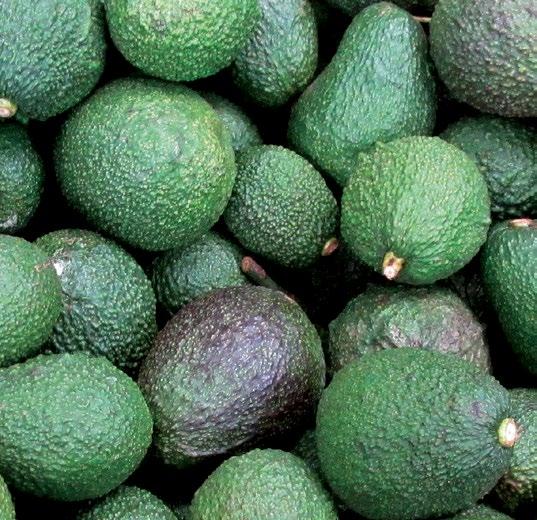
To enhance crop consistency and resilience, initiatives to trial newly imported rootstock varieties from the United States and Israel are underway. While these endeavours require time and patience, we have seen from past cultivar introductions that this work is vital for strengthening the sector’s long-term viability and competitiveness.
This year, NZ Avocado will be seeking growers’ views on the six-yearly avocado Commodity Levy Order, which is due for renewal in June 2025. Key elements of the Order which funds all activities of the association include the maximum rate of levy and what levy funds can be spent on. A number of horticulture sectors, including Horticulture New Zealand, are also going through this process with similar timelines for their Levy Order. Growers should therefore expect direct engagement on this process, so they are adequately informed and can participate in consultation and voting.
As the industry navigates through turbulent times, ensuring market access and food security remain important aspects to the industry. Through coordinated efforts across the supply chain, the New Zealand avocado sector looks towards overcoming challenges and securing its position in the global market landscape.
60 The ORCHARDIST : MAY 2024 FINAL PICK
John Deere’s unprecedented commitment to HVC
In 2024–25, the High Value Crop (HVC) sector will reach a new record of $17.8 billion in its value of production, positioning it as the third largest agricultural industry in New Zealand.
Horticulture is outpacing every other primary industry, and as global demand for food grows, its importance will only continue to rise.
At John Deere, we believe we are ideally placed to support growers by bringing the world’s best precision agriculture technology to the HVC sector.
Broadacre farming has reaped the benefits of technology and innovation over the past two to three decades, but horticulture has not enjoyed the same evolution, and this is now something we are committed to addressing. We want to start to bring HVC producers in line with their broadacre counterparts by applying and further developing technology already proven in the grain and cotton industries.
Unique challenges
We understand and appreciate the unique challenges faced by our HVC customers in boosting the efficiency and productivity of their operations – be that limitation around machine form size, coverage under canopy or the range of implements available for specific crop types and farming practices.
Access to skilled labour is one of the greatest limitations to efficiency and productivity, particularly during periods when windows are tight such as spraying and harvest –and we’re prioritising investment in automation to deliver solutions that are scalable depending on what workforce is available.
Data management is another priority for the HVC sector, and we are committed to connecting 100 percent of all John Deere small tractors to online information technology to support documentation and traceability. With the growing pressure input costs are placing on production systems, we’re working hard to deliver solutions that reduce overall costs of production for customers. Over the past two years, John Deere has introduced many solutions and technologies to address these obstacles.

For example, the 5ML Tractor is specifically designed to meet the unique requirements of orchard and vineyard production, while precision agriculture technologies such as automated guidance system AutoTracTM, that were previously only placed on large agricultural machines, are now available in HVC equipment.
SmartApply® can help growers achieve up to 93 percent less chemical run-off and up to an 87 percent reduction in airborne drift, while reducing chemical and water use by an average of 50 percent. Additionally, our joint venture with GUSS is delivering spray units that bring together a sophisticated combination of GPS (global positioning systems) and light detection and ranging (LiDAR), vehicle sensors and software to navigate through rows autonomously.
From an overarching perspective, integration of tech and in-field monitoring with John Deere Operations CenterTM means growers can access another level of insight and data analysis to support better documentation, traceability and data-informed management decisions.
You deserve to have the world’s best tech powering your machine.
For more information, visit John Deere at its worldwide website at JohnDeere.com or in New Zealand at JohnDeere.co.nz.
The ORCHARDIST : MAY 2024 61 WHAT’S NEW
The John Deere 5ML Tractor is specifically designed to meet the unique requirements of orchard and vineyard production
GEARING UP FOR GREATER GAINS
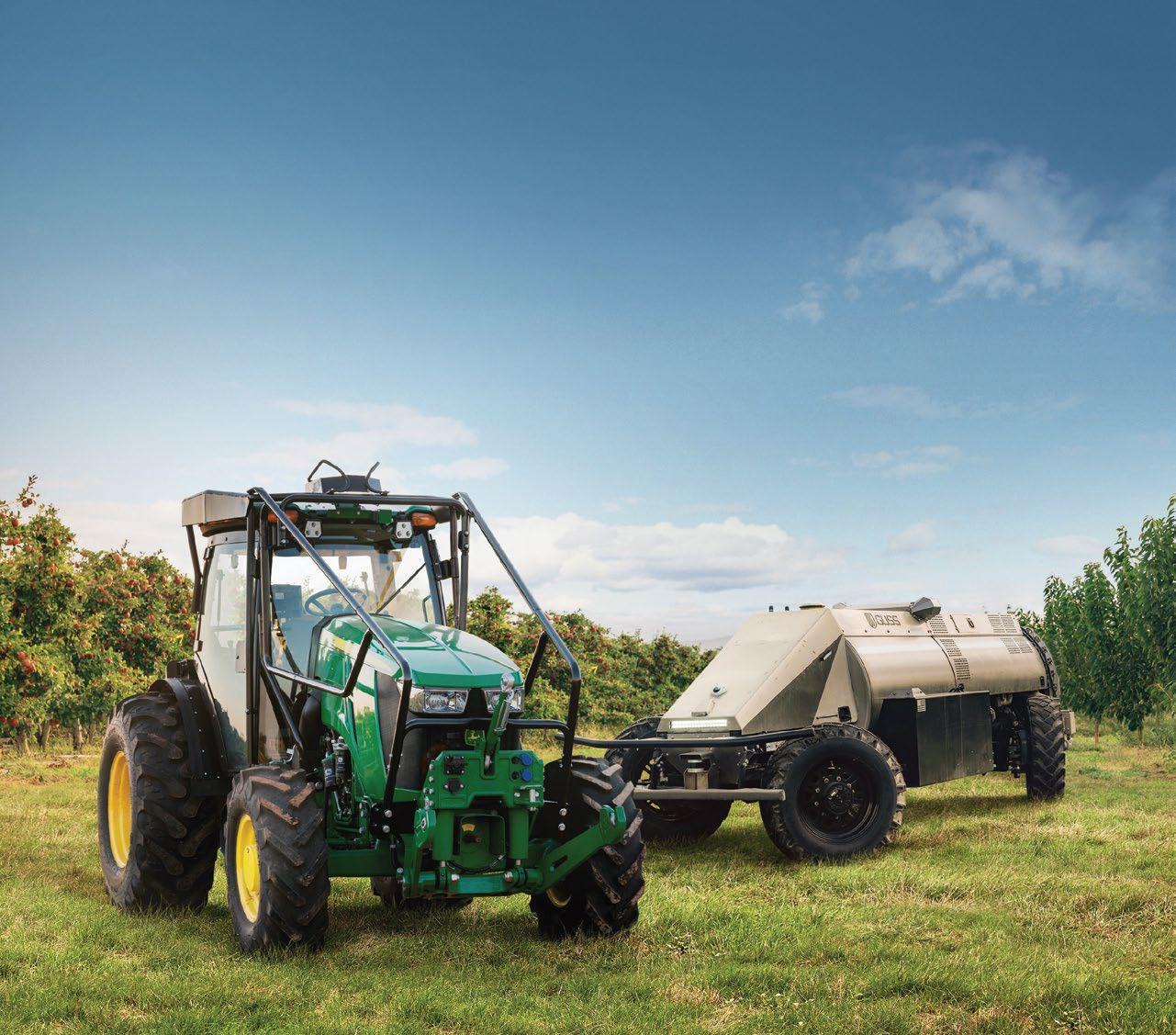


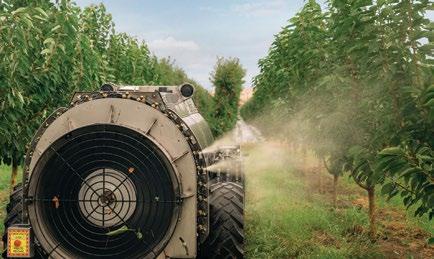
You called for enhanced hardware and cutting-edge precision technology to drive gains across your operation. And we’ve answered with a holistic solution purpose-built for orchards and vineyards.
Introducing the 5ML tractor with unprecedented power and narrow axle offerings. Meet Smart Apply, a LiDAR spray system that targets only the canopy, slashing input costs by minimising chemical usage. Plus, experience the Global Unmanned Spray System (GUSS), a semi-autonomous sprayer that independently manoeuvres through rows, mitigating human error and labour constraints.
We’ve made in-roads but it’s only the start of our shared journey towards enhanced productivity, efficiency, and sustainability.
Talk to your local John Deere dealer, today.






























 Southern Belle picker Julieta Gonzalez
Southern Belle picker Julieta Gonzalez














 A team plucks gold kiwifruit from the vines at Willisbrook Orchards
A team plucks gold kiwifruit from the vines at Willisbrook Orchards






 Prune and heal with VistaSeal!
Available from Farmlands
Prune and heal with VistaSeal!
Available from Farmlands










 Professor Richard Newcomb
Professor Richard Newcomb





 Kiwifruit are a consumer favourite in the French Territories –on display here in a New Caledonia supermarket
Kiwifruit are a consumer favourite in the French Territories –on display here in a New Caledonia supermarket












































































 Wonky Box co-founder Katie Jackson meeting with orchardist Hugh Findlay from Cherry Gold Orchards in Hawke’s Bay
Wonky Box co-founder Katie Jackson meeting with orchardist Hugh Findlay from Cherry Gold Orchards in Hawke’s Bay
































